Sustainability Challenges in Automobile Industry
VerifiedAdded on 2021/04/21
|22
|5544
|25
AI Summary
This assignment deals with the major sustainability challenges for the automobile industry, including climate change. It discusses how the industry contributes to environmental issues and how organizations are addressing these problems through technological innovations such as electric cars and hydrogen gas drive cars. The assignment also highlights gaps in research and development, particularly among smaller companies, and the need for more investment in alternative fuels.
Contribute Materials
Your contribution can guide someone’s learning journey. Share your
documents today.
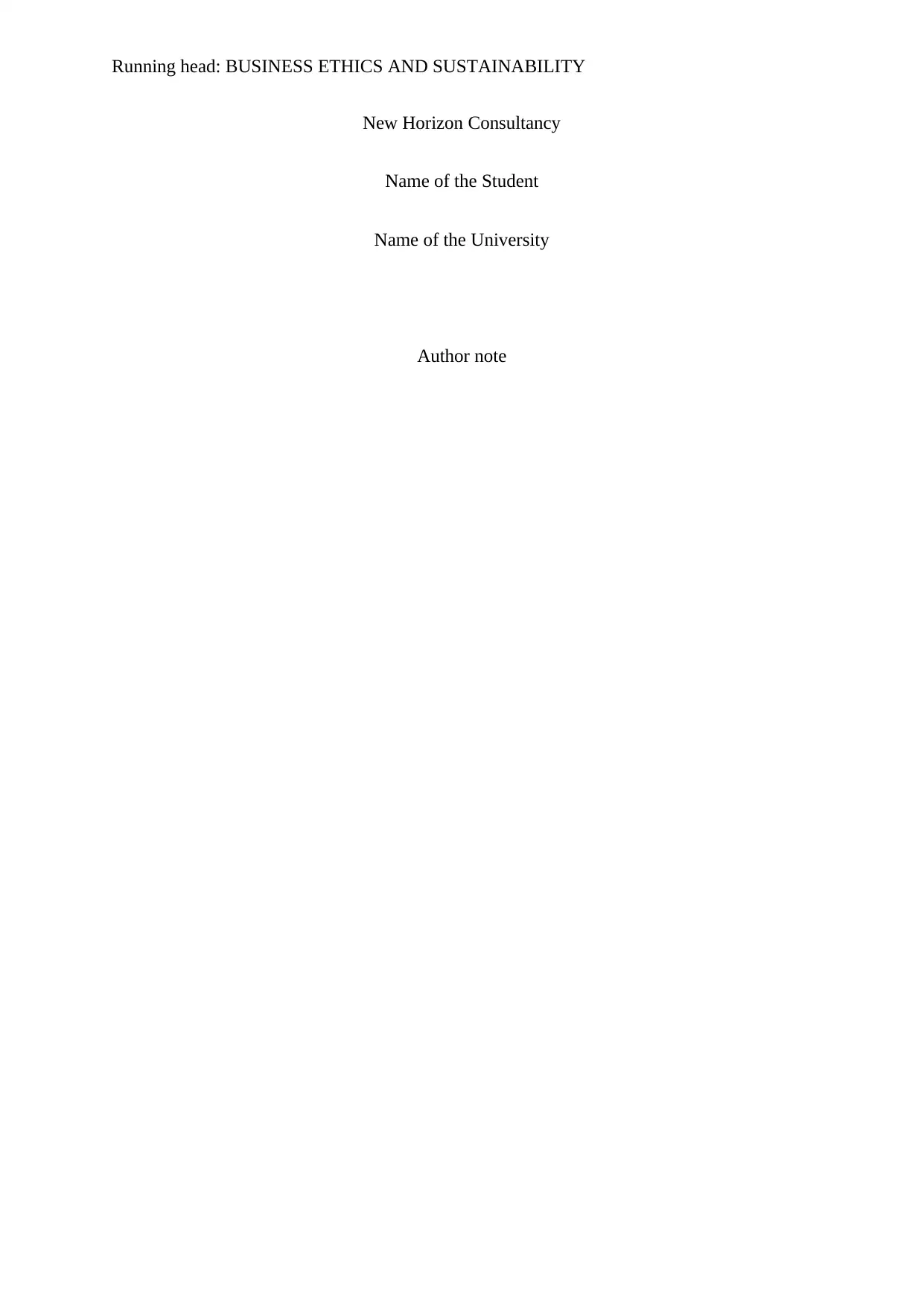
Running head: BUSINESS ETHICS AND SUSTAINABILITY
New Horizon Consultancy
Name of the Student
Name of the University
Author note
New Horizon Consultancy
Name of the Student
Name of the University
Author note
Secure Best Marks with AI Grader
Need help grading? Try our AI Grader for instant feedback on your assignments.
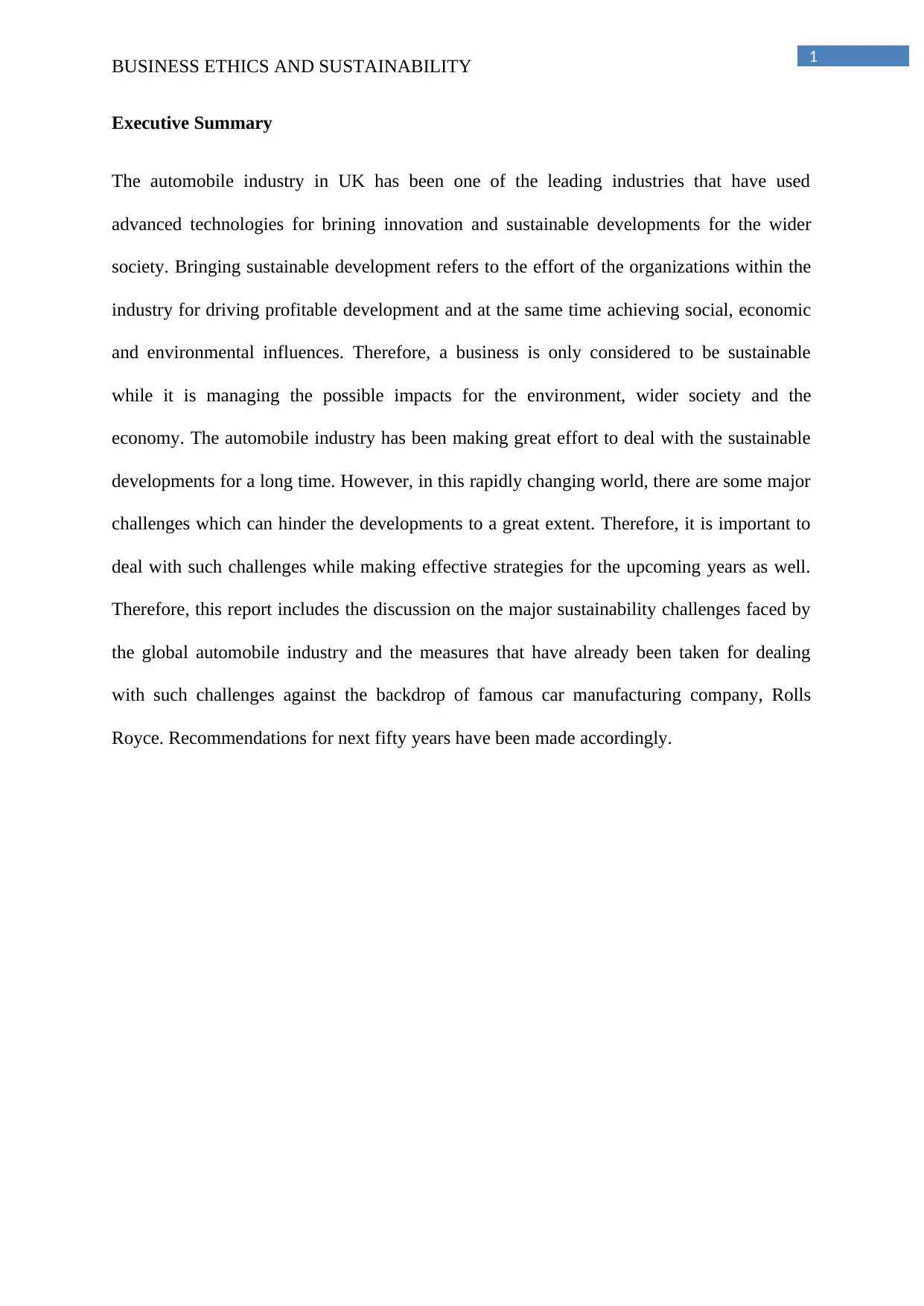
1
BUSINESS ETHICS AND SUSTAINABILITY
Executive Summary
The automobile industry in UK has been one of the leading industries that have used
advanced technologies for brining innovation and sustainable developments for the wider
society. Bringing sustainable development refers to the effort of the organizations within the
industry for driving profitable development and at the same time achieving social, economic
and environmental influences. Therefore, a business is only considered to be sustainable
while it is managing the possible impacts for the environment, wider society and the
economy. The automobile industry has been making great effort to deal with the sustainable
developments for a long time. However, in this rapidly changing world, there are some major
challenges which can hinder the developments to a great extent. Therefore, it is important to
deal with such challenges while making effective strategies for the upcoming years as well.
Therefore, this report includes the discussion on the major sustainability challenges faced by
the global automobile industry and the measures that have already been taken for dealing
with such challenges against the backdrop of famous car manufacturing company, Rolls
Royce. Recommendations for next fifty years have been made accordingly.
BUSINESS ETHICS AND SUSTAINABILITY
Executive Summary
The automobile industry in UK has been one of the leading industries that have used
advanced technologies for brining innovation and sustainable developments for the wider
society. Bringing sustainable development refers to the effort of the organizations within the
industry for driving profitable development and at the same time achieving social, economic
and environmental influences. Therefore, a business is only considered to be sustainable
while it is managing the possible impacts for the environment, wider society and the
economy. The automobile industry has been making great effort to deal with the sustainable
developments for a long time. However, in this rapidly changing world, there are some major
challenges which can hinder the developments to a great extent. Therefore, it is important to
deal with such challenges while making effective strategies for the upcoming years as well.
Therefore, this report includes the discussion on the major sustainability challenges faced by
the global automobile industry and the measures that have already been taken for dealing
with such challenges against the backdrop of famous car manufacturing company, Rolls
Royce. Recommendations for next fifty years have been made accordingly.
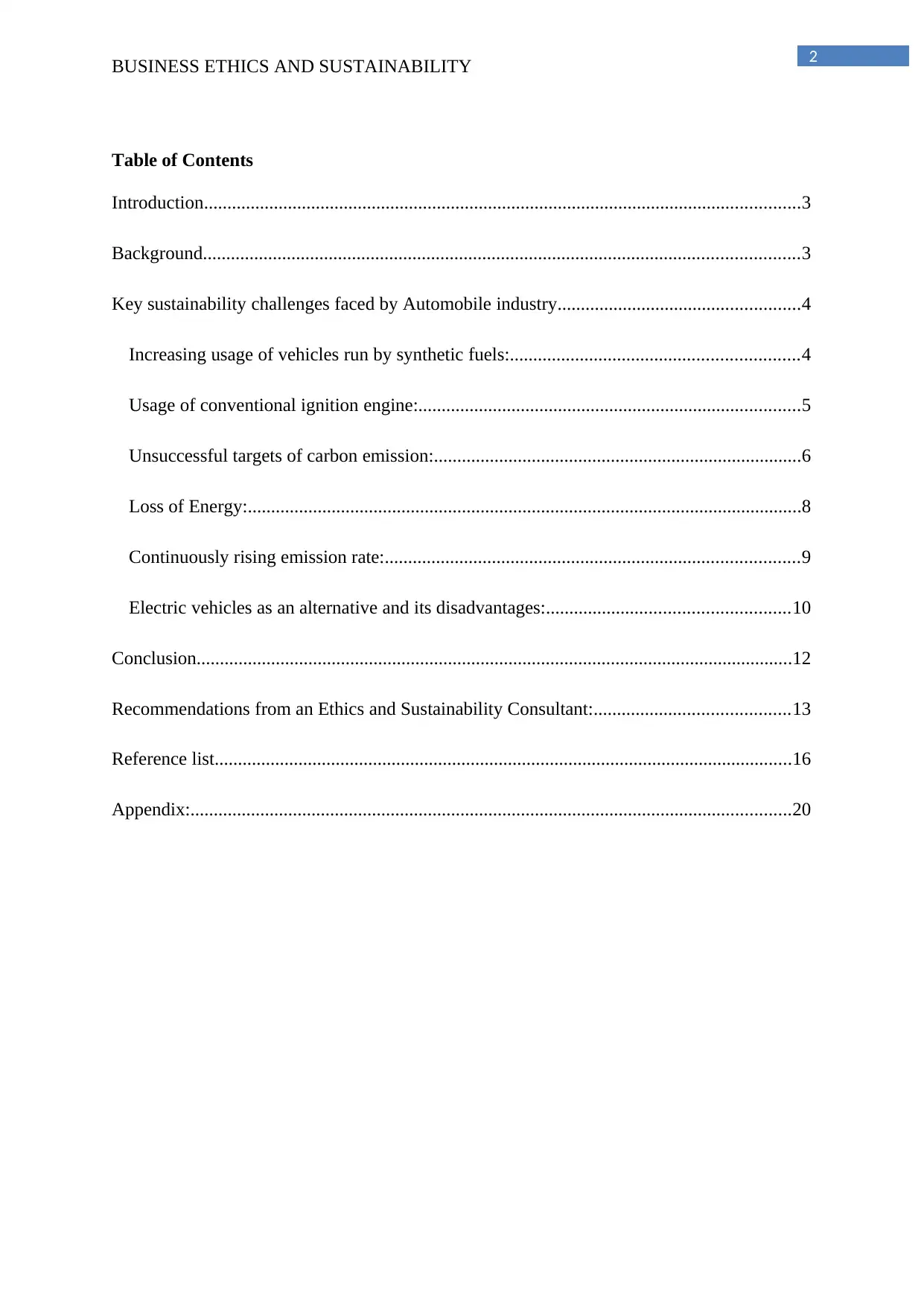
2
BUSINESS ETHICS AND SUSTAINABILITY
Table of Contents
Introduction................................................................................................................................3
Background................................................................................................................................3
Key sustainability challenges faced by Automobile industry....................................................4
Increasing usage of vehicles run by synthetic fuels:..............................................................4
Usage of conventional ignition engine:..................................................................................5
Unsuccessful targets of carbon emission:...............................................................................6
Loss of Energy:.......................................................................................................................8
Continuously rising emission rate:.........................................................................................9
Electric vehicles as an alternative and its disadvantages:....................................................10
Conclusion................................................................................................................................12
Recommendations from an Ethics and Sustainability Consultant:..........................................13
Reference list............................................................................................................................16
Appendix:.................................................................................................................................20
BUSINESS ETHICS AND SUSTAINABILITY
Table of Contents
Introduction................................................................................................................................3
Background................................................................................................................................3
Key sustainability challenges faced by Automobile industry....................................................4
Increasing usage of vehicles run by synthetic fuels:..............................................................4
Usage of conventional ignition engine:..................................................................................5
Unsuccessful targets of carbon emission:...............................................................................6
Loss of Energy:.......................................................................................................................8
Continuously rising emission rate:.........................................................................................9
Electric vehicles as an alternative and its disadvantages:....................................................10
Conclusion................................................................................................................................12
Recommendations from an Ethics and Sustainability Consultant:..........................................13
Reference list............................................................................................................................16
Appendix:.................................................................................................................................20
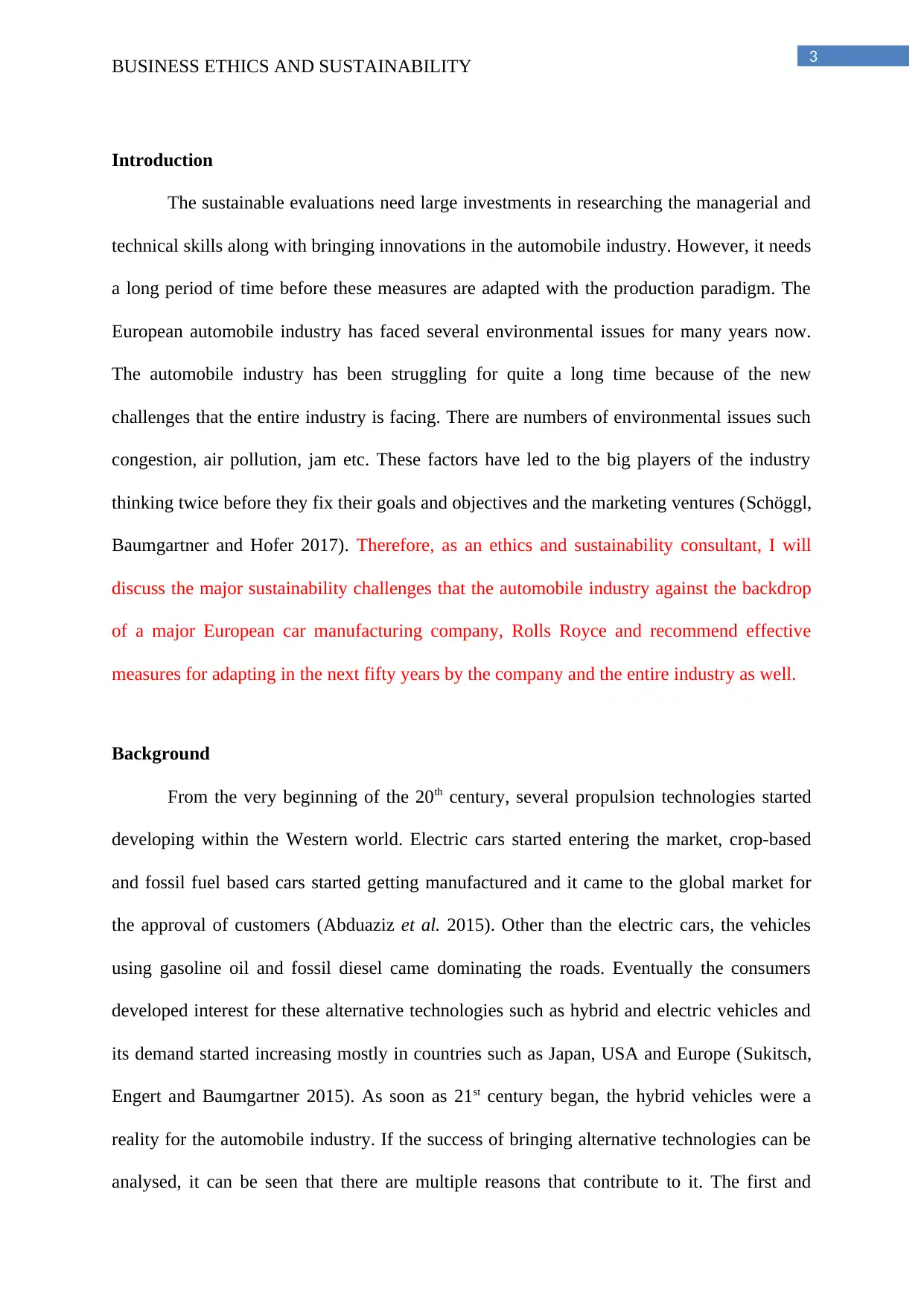
3
BUSINESS ETHICS AND SUSTAINABILITY
Introduction
The sustainable evaluations need large investments in researching the managerial and
technical skills along with bringing innovations in the automobile industry. However, it needs
a long period of time before these measures are adapted with the production paradigm. The
European automobile industry has faced several environmental issues for many years now.
The automobile industry has been struggling for quite a long time because of the new
challenges that the entire industry is facing. There are numbers of environmental issues such
congestion, air pollution, jam etc. These factors have led to the big players of the industry
thinking twice before they fix their goals and objectives and the marketing ventures (Schöggl,
Baumgartner and Hofer 2017). Therefore, as an ethics and sustainability consultant, I will
discuss the major sustainability challenges that the automobile industry against the backdrop
of a major European car manufacturing company, Rolls Royce and recommend effective
measures for adapting in the next fifty years by the company and the entire industry as well.
Background
From the very beginning of the 20th century, several propulsion technologies started
developing within the Western world. Electric cars started entering the market, crop-based
and fossil fuel based cars started getting manufactured and it came to the global market for
the approval of customers (Abduaziz et al. 2015). Other than the electric cars, the vehicles
using gasoline oil and fossil diesel came dominating the roads. Eventually the consumers
developed interest for these alternative technologies such as hybrid and electric vehicles and
its demand started increasing mostly in countries such as Japan, USA and Europe (Sukitsch,
Engert and Baumgartner 2015). As soon as 21st century began, the hybrid vehicles were a
reality for the automobile industry. If the success of bringing alternative technologies can be
analysed, it can be seen that there are multiple reasons that contribute to it. The first and
BUSINESS ETHICS AND SUSTAINABILITY
Introduction
The sustainable evaluations need large investments in researching the managerial and
technical skills along with bringing innovations in the automobile industry. However, it needs
a long period of time before these measures are adapted with the production paradigm. The
European automobile industry has faced several environmental issues for many years now.
The automobile industry has been struggling for quite a long time because of the new
challenges that the entire industry is facing. There are numbers of environmental issues such
congestion, air pollution, jam etc. These factors have led to the big players of the industry
thinking twice before they fix their goals and objectives and the marketing ventures (Schöggl,
Baumgartner and Hofer 2017). Therefore, as an ethics and sustainability consultant, I will
discuss the major sustainability challenges that the automobile industry against the backdrop
of a major European car manufacturing company, Rolls Royce and recommend effective
measures for adapting in the next fifty years by the company and the entire industry as well.
Background
From the very beginning of the 20th century, several propulsion technologies started
developing within the Western world. Electric cars started entering the market, crop-based
and fossil fuel based cars started getting manufactured and it came to the global market for
the approval of customers (Abduaziz et al. 2015). Other than the electric cars, the vehicles
using gasoline oil and fossil diesel came dominating the roads. Eventually the consumers
developed interest for these alternative technologies such as hybrid and electric vehicles and
its demand started increasing mostly in countries such as Japan, USA and Europe (Sukitsch,
Engert and Baumgartner 2015). As soon as 21st century began, the hybrid vehicles were a
reality for the automobile industry. If the success of bringing alternative technologies can be
analysed, it can be seen that there are multiple reasons that contribute to it. The first and
Secure Best Marks with AI Grader
Need help grading? Try our AI Grader for instant feedback on your assignments.
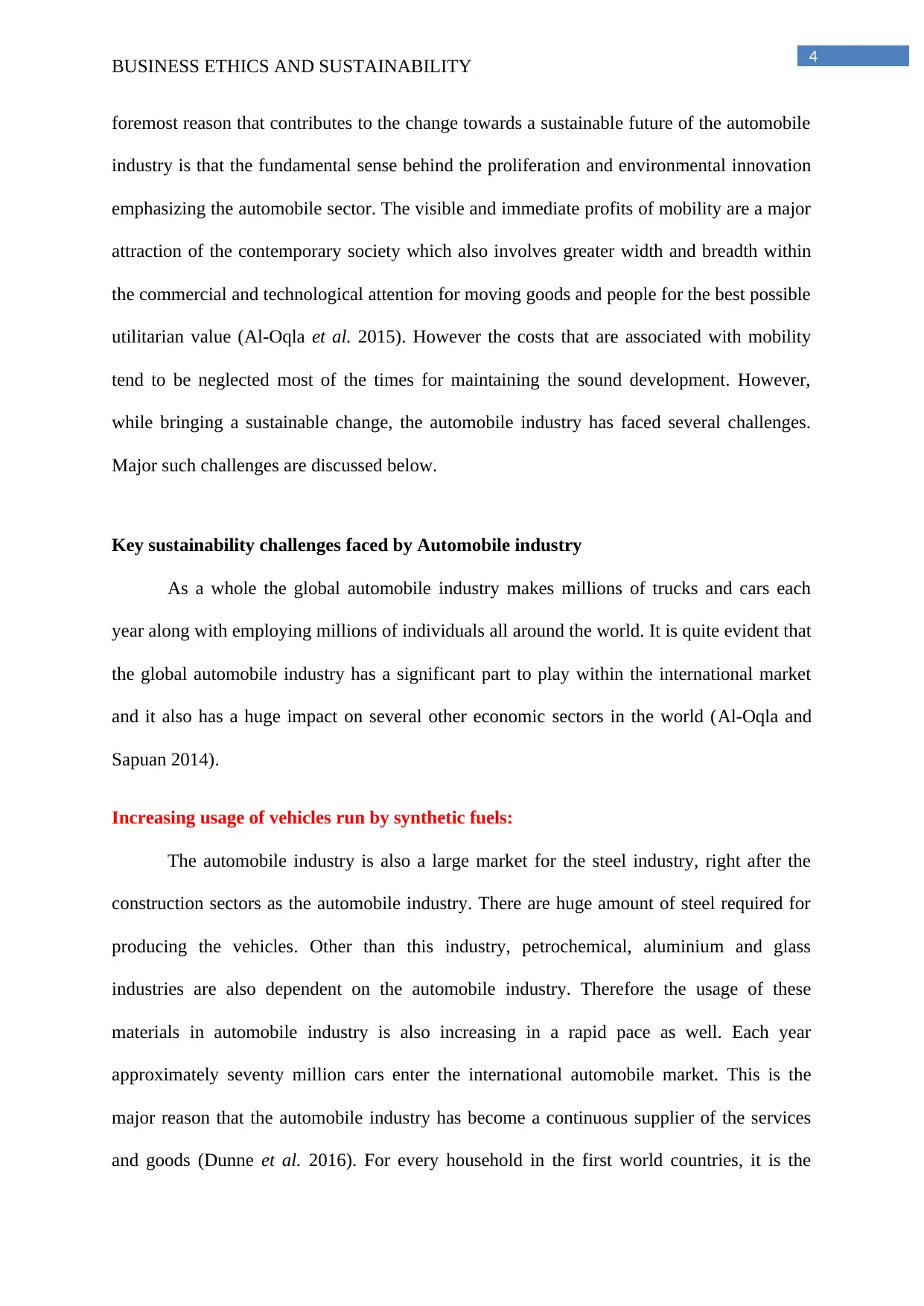
4
BUSINESS ETHICS AND SUSTAINABILITY
foremost reason that contributes to the change towards a sustainable future of the automobile
industry is that the fundamental sense behind the proliferation and environmental innovation
emphasizing the automobile sector. The visible and immediate profits of mobility are a major
attraction of the contemporary society which also involves greater width and breadth within
the commercial and technological attention for moving goods and people for the best possible
utilitarian value (Al-Oqla et al. 2015). However the costs that are associated with mobility
tend to be neglected most of the times for maintaining the sound development. However,
while bringing a sustainable change, the automobile industry has faced several challenges.
Major such challenges are discussed below.
Key sustainability challenges faced by Automobile industry
As a whole the global automobile industry makes millions of trucks and cars each
year along with employing millions of individuals all around the world. It is quite evident that
the global automobile industry has a significant part to play within the international market
and it also has a huge impact on several other economic sectors in the world (Al-Oqla and
Sapuan 2014).
Increasing usage of vehicles run by synthetic fuels:
The automobile industry is also a large market for the steel industry, right after the
construction sectors as the automobile industry. There are huge amount of steel required for
producing the vehicles. Other than this industry, petrochemical, aluminium and glass
industries are also dependent on the automobile industry. Therefore the usage of these
materials in automobile industry is also increasing in a rapid pace as well. Each year
approximately seventy million cars enter the international automobile market. This is the
major reason that the automobile industry has become a continuous supplier of the services
and goods (Dunne et al. 2016). For every household in the first world countries, it is the
BUSINESS ETHICS AND SUSTAINABILITY
foremost reason that contributes to the change towards a sustainable future of the automobile
industry is that the fundamental sense behind the proliferation and environmental innovation
emphasizing the automobile sector. The visible and immediate profits of mobility are a major
attraction of the contemporary society which also involves greater width and breadth within
the commercial and technological attention for moving goods and people for the best possible
utilitarian value (Al-Oqla et al. 2015). However the costs that are associated with mobility
tend to be neglected most of the times for maintaining the sound development. However,
while bringing a sustainable change, the automobile industry has faced several challenges.
Major such challenges are discussed below.
Key sustainability challenges faced by Automobile industry
As a whole the global automobile industry makes millions of trucks and cars each
year along with employing millions of individuals all around the world. It is quite evident that
the global automobile industry has a significant part to play within the international market
and it also has a huge impact on several other economic sectors in the world (Al-Oqla and
Sapuan 2014).
Increasing usage of vehicles run by synthetic fuels:
The automobile industry is also a large market for the steel industry, right after the
construction sectors as the automobile industry. There are huge amount of steel required for
producing the vehicles. Other than this industry, petrochemical, aluminium and glass
industries are also dependent on the automobile industry. Therefore the usage of these
materials in automobile industry is also increasing in a rapid pace as well. Each year
approximately seventy million cars enter the international automobile market. This is the
major reason that the automobile industry has become a continuous supplier of the services
and goods (Dunne et al. 2016). For every household in the first world countries, it is the
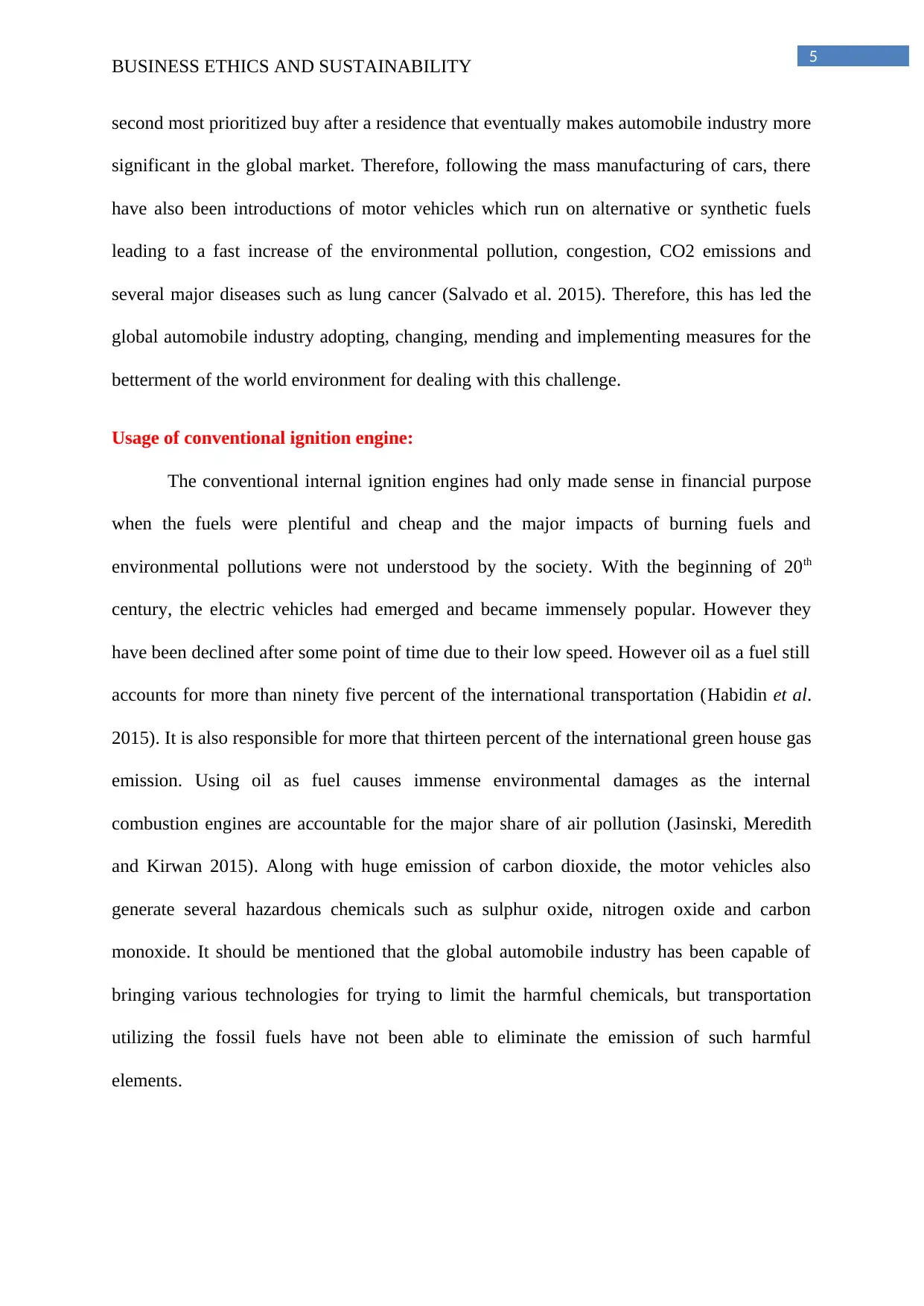
5
BUSINESS ETHICS AND SUSTAINABILITY
second most prioritized buy after a residence that eventually makes automobile industry more
significant in the global market. Therefore, following the mass manufacturing of cars, there
have also been introductions of motor vehicles which run on alternative or synthetic fuels
leading to a fast increase of the environmental pollution, congestion, CO2 emissions and
several major diseases such as lung cancer (Salvado et al. 2015). Therefore, this has led the
global automobile industry adopting, changing, mending and implementing measures for the
betterment of the world environment for dealing with this challenge.
Usage of conventional ignition engine:
The conventional internal ignition engines had only made sense in financial purpose
when the fuels were plentiful and cheap and the major impacts of burning fuels and
environmental pollutions were not understood by the society. With the beginning of 20th
century, the electric vehicles had emerged and became immensely popular. However they
have been declined after some point of time due to their low speed. However oil as a fuel still
accounts for more than ninety five percent of the international transportation (Habidin et al.
2015). It is also responsible for more that thirteen percent of the international green house gas
emission. Using oil as fuel causes immense environmental damages as the internal
combustion engines are accountable for the major share of air pollution (Jasinski, Meredith
and Kirwan 2015). Along with huge emission of carbon dioxide, the motor vehicles also
generate several hazardous chemicals such as sulphur oxide, nitrogen oxide and carbon
monoxide. It should be mentioned that the global automobile industry has been capable of
bringing various technologies for trying to limit the harmful chemicals, but transportation
utilizing the fossil fuels have not been able to eliminate the emission of such harmful
elements.
BUSINESS ETHICS AND SUSTAINABILITY
second most prioritized buy after a residence that eventually makes automobile industry more
significant in the global market. Therefore, following the mass manufacturing of cars, there
have also been introductions of motor vehicles which run on alternative or synthetic fuels
leading to a fast increase of the environmental pollution, congestion, CO2 emissions and
several major diseases such as lung cancer (Salvado et al. 2015). Therefore, this has led the
global automobile industry adopting, changing, mending and implementing measures for the
betterment of the world environment for dealing with this challenge.
Usage of conventional ignition engine:
The conventional internal ignition engines had only made sense in financial purpose
when the fuels were plentiful and cheap and the major impacts of burning fuels and
environmental pollutions were not understood by the society. With the beginning of 20th
century, the electric vehicles had emerged and became immensely popular. However they
have been declined after some point of time due to their low speed. However oil as a fuel still
accounts for more than ninety five percent of the international transportation (Habidin et al.
2015). It is also responsible for more that thirteen percent of the international green house gas
emission. Using oil as fuel causes immense environmental damages as the internal
combustion engines are accountable for the major share of air pollution (Jasinski, Meredith
and Kirwan 2015). Along with huge emission of carbon dioxide, the motor vehicles also
generate several hazardous chemicals such as sulphur oxide, nitrogen oxide and carbon
monoxide. It should be mentioned that the global automobile industry has been capable of
bringing various technologies for trying to limit the harmful chemicals, but transportation
utilizing the fossil fuels have not been able to eliminate the emission of such harmful
elements.
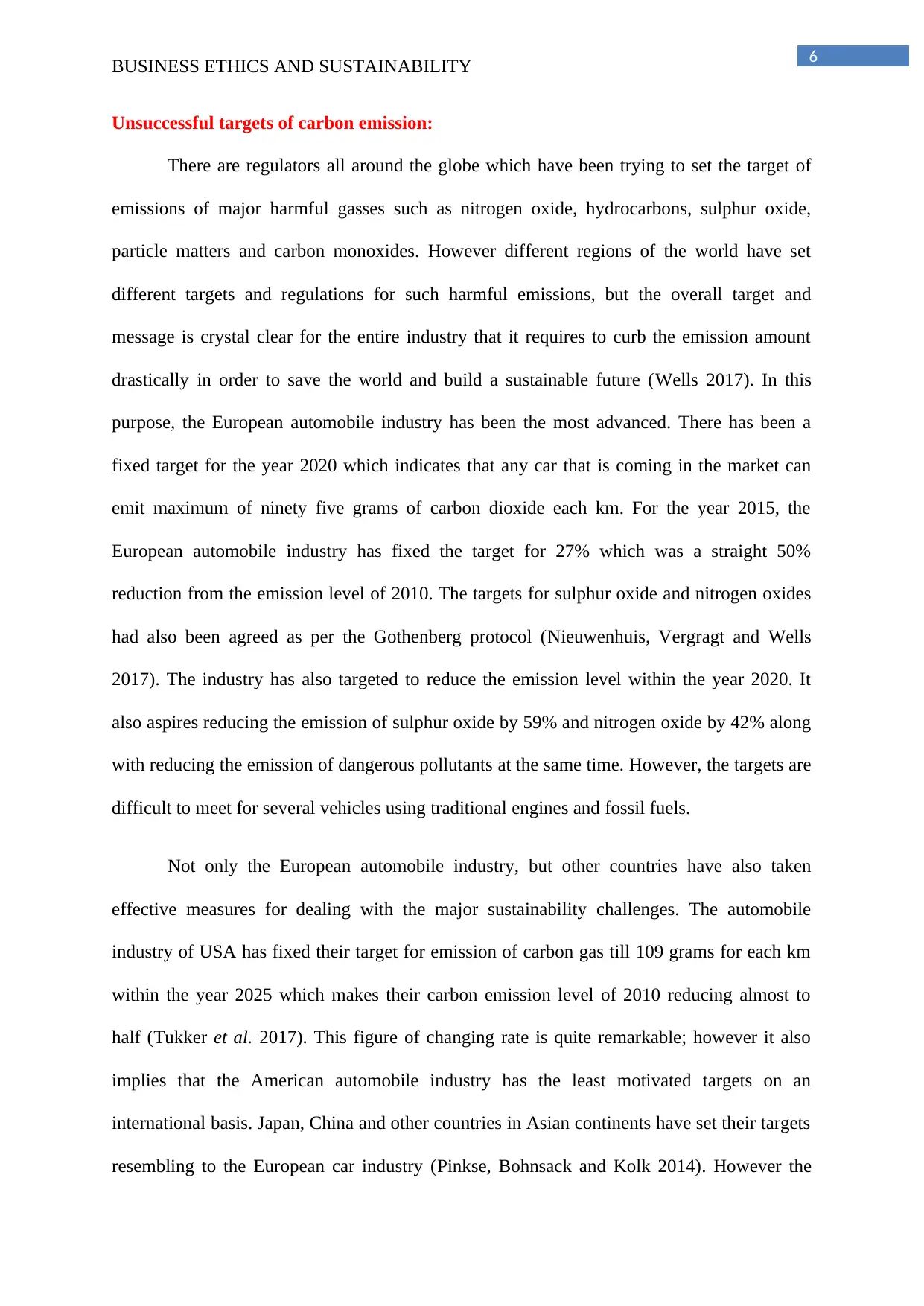
6
BUSINESS ETHICS AND SUSTAINABILITY
Unsuccessful targets of carbon emission:
There are regulators all around the globe which have been trying to set the target of
emissions of major harmful gasses such as nitrogen oxide, hydrocarbons, sulphur oxide,
particle matters and carbon monoxides. However different regions of the world have set
different targets and regulations for such harmful emissions, but the overall target and
message is crystal clear for the entire industry that it requires to curb the emission amount
drastically in order to save the world and build a sustainable future (Wells 2017). In this
purpose, the European automobile industry has been the most advanced. There has been a
fixed target for the year 2020 which indicates that any car that is coming in the market can
emit maximum of ninety five grams of carbon dioxide each km. For the year 2015, the
European automobile industry has fixed the target for 27% which was a straight 50%
reduction from the emission level of 2010. The targets for sulphur oxide and nitrogen oxides
had also been agreed as per the Gothenberg protocol (Nieuwenhuis, Vergragt and Wells
2017). The industry has also targeted to reduce the emission level within the year 2020. It
also aspires reducing the emission of sulphur oxide by 59% and nitrogen oxide by 42% along
with reducing the emission of dangerous pollutants at the same time. However, the targets are
difficult to meet for several vehicles using traditional engines and fossil fuels.
Not only the European automobile industry, but other countries have also taken
effective measures for dealing with the major sustainability challenges. The automobile
industry of USA has fixed their target for emission of carbon gas till 109 grams for each km
within the year 2025 which makes their carbon emission level of 2010 reducing almost to
half (Tukker et al. 2017). This figure of changing rate is quite remarkable; however it also
implies that the American automobile industry has the least motivated targets on an
international basis. Japan, China and other countries in Asian continents have set their targets
resembling to the European car industry (Pinkse, Bohnsack and Kolk 2014). However the
BUSINESS ETHICS AND SUSTAINABILITY
Unsuccessful targets of carbon emission:
There are regulators all around the globe which have been trying to set the target of
emissions of major harmful gasses such as nitrogen oxide, hydrocarbons, sulphur oxide,
particle matters and carbon monoxides. However different regions of the world have set
different targets and regulations for such harmful emissions, but the overall target and
message is crystal clear for the entire industry that it requires to curb the emission amount
drastically in order to save the world and build a sustainable future (Wells 2017). In this
purpose, the European automobile industry has been the most advanced. There has been a
fixed target for the year 2020 which indicates that any car that is coming in the market can
emit maximum of ninety five grams of carbon dioxide each km. For the year 2015, the
European automobile industry has fixed the target for 27% which was a straight 50%
reduction from the emission level of 2010. The targets for sulphur oxide and nitrogen oxides
had also been agreed as per the Gothenberg protocol (Nieuwenhuis, Vergragt and Wells
2017). The industry has also targeted to reduce the emission level within the year 2020. It
also aspires reducing the emission of sulphur oxide by 59% and nitrogen oxide by 42% along
with reducing the emission of dangerous pollutants at the same time. However, the targets are
difficult to meet for several vehicles using traditional engines and fossil fuels.
Not only the European automobile industry, but other countries have also taken
effective measures for dealing with the major sustainability challenges. The automobile
industry of USA has fixed their target for emission of carbon gas till 109 grams for each km
within the year 2025 which makes their carbon emission level of 2010 reducing almost to
half (Tukker et al. 2017). This figure of changing rate is quite remarkable; however it also
implies that the American automobile industry has the least motivated targets on an
international basis. Japan, China and other countries in Asian continents have set their targets
resembling to the European car industry (Pinkse, Bohnsack and Kolk 2014). However the
Paraphrase This Document
Need a fresh take? Get an instant paraphrase of this document with our AI Paraphraser
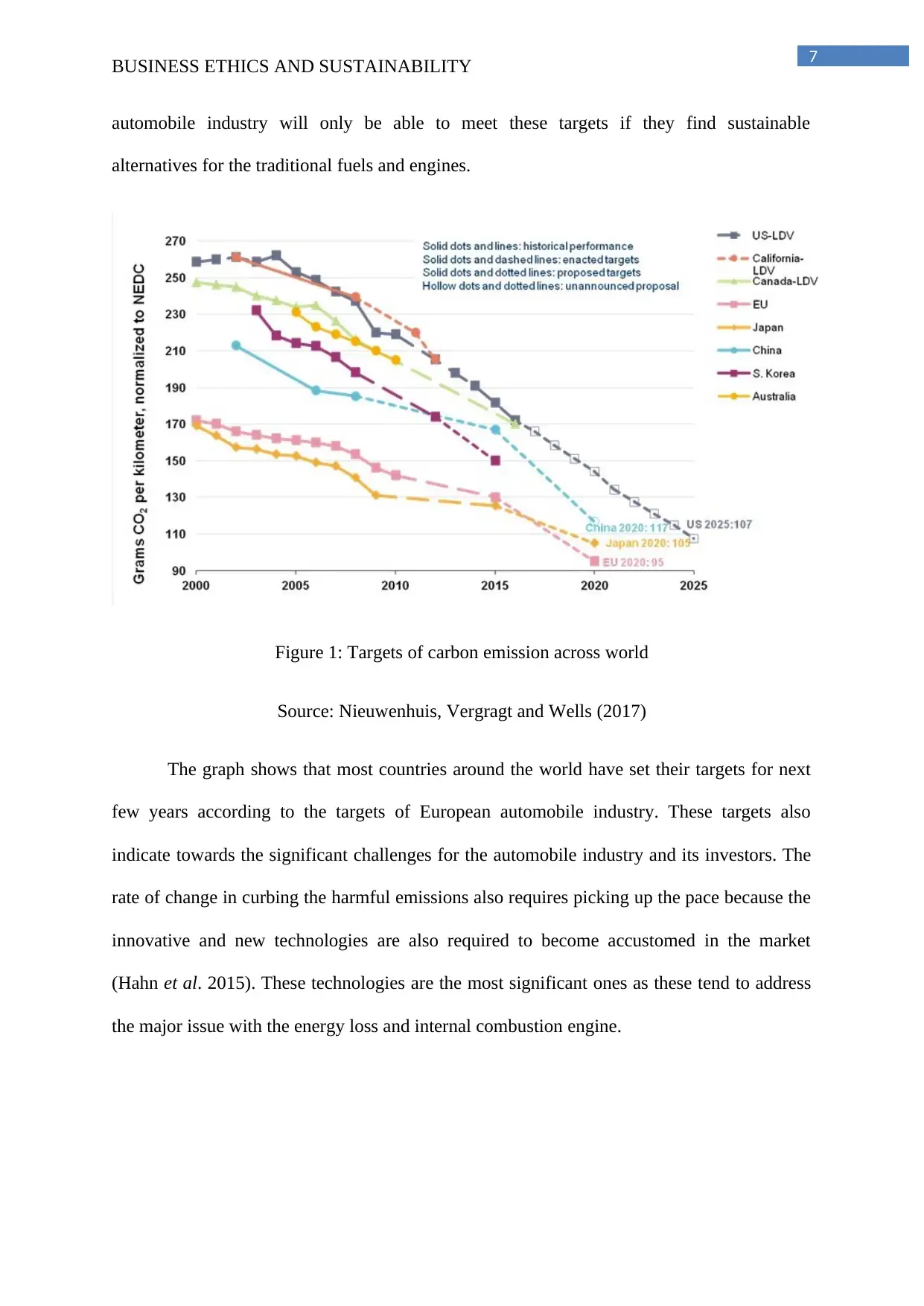
7
BUSINESS ETHICS AND SUSTAINABILITY
automobile industry will only be able to meet these targets if they find sustainable
alternatives for the traditional fuels and engines.
Figure 1: Targets of carbon emission across world
Source: Nieuwenhuis, Vergragt and Wells (2017)
The graph shows that most countries around the world have set their targets for next
few years according to the targets of European automobile industry. These targets also
indicate towards the significant challenges for the automobile industry and its investors. The
rate of change in curbing the harmful emissions also requires picking up the pace because the
innovative and new technologies are also required to become accustomed in the market
(Hahn et al. 2015). These technologies are the most significant ones as these tend to address
the major issue with the energy loss and internal combustion engine.
BUSINESS ETHICS AND SUSTAINABILITY
automobile industry will only be able to meet these targets if they find sustainable
alternatives for the traditional fuels and engines.
Figure 1: Targets of carbon emission across world
Source: Nieuwenhuis, Vergragt and Wells (2017)
The graph shows that most countries around the world have set their targets for next
few years according to the targets of European automobile industry. These targets also
indicate towards the significant challenges for the automobile industry and its investors. The
rate of change in curbing the harmful emissions also requires picking up the pace because the
innovative and new technologies are also required to become accustomed in the market
(Hahn et al. 2015). These technologies are the most significant ones as these tend to address
the major issue with the energy loss and internal combustion engine.
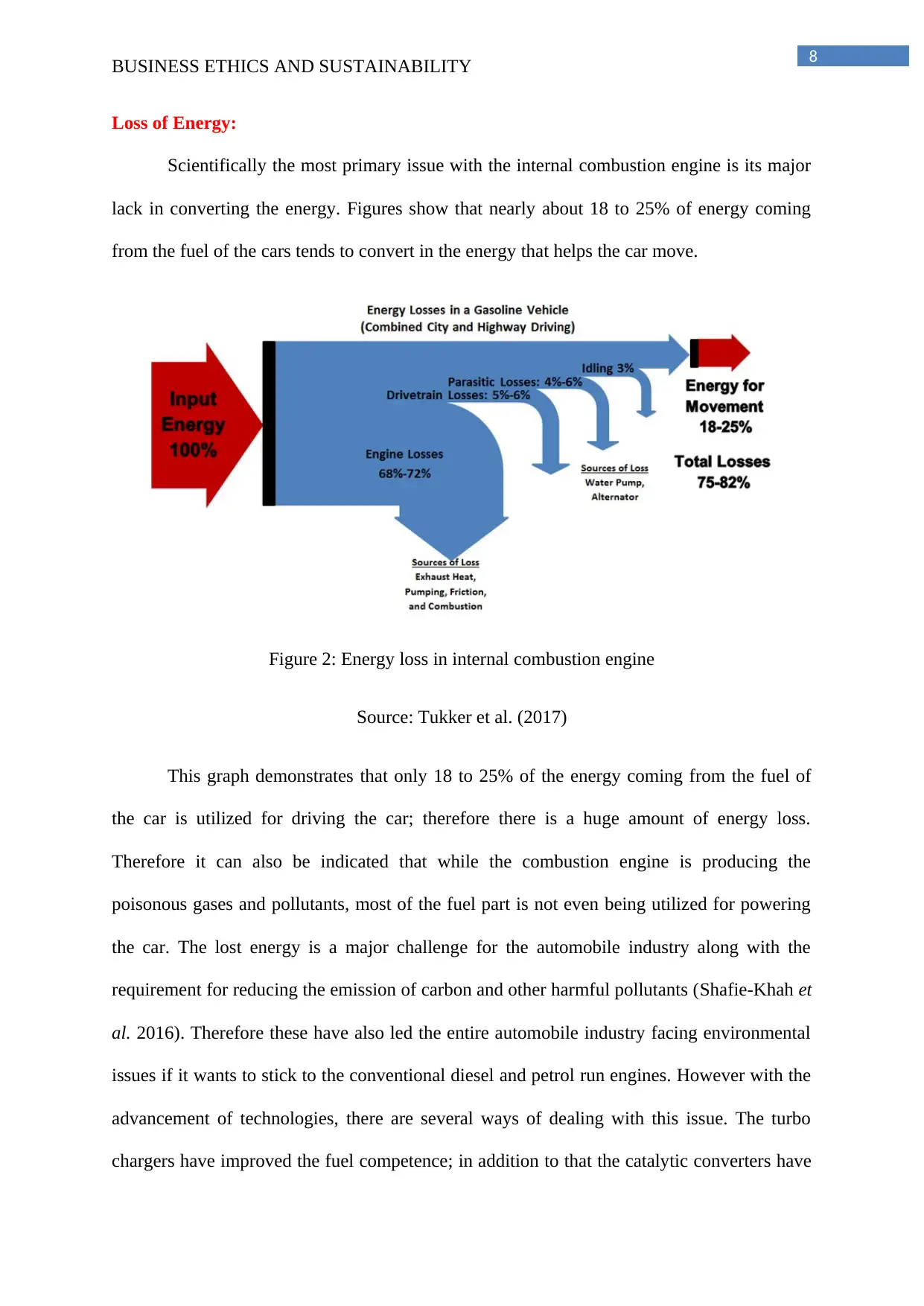
8
BUSINESS ETHICS AND SUSTAINABILITY
Loss of Energy:
Scientifically the most primary issue with the internal combustion engine is its major
lack in converting the energy. Figures show that nearly about 18 to 25% of energy coming
from the fuel of the cars tends to convert in the energy that helps the car move.
Figure 2: Energy loss in internal combustion engine
Source: Tukker et al. (2017)
This graph demonstrates that only 18 to 25% of the energy coming from the fuel of
the car is utilized for driving the car; therefore there is a huge amount of energy loss.
Therefore it can also be indicated that while the combustion engine is producing the
poisonous gases and pollutants, most of the fuel part is not even being utilized for powering
the car. The lost energy is a major challenge for the automobile industry along with the
requirement for reducing the emission of carbon and other harmful pollutants (Shafie-Khah et
al. 2016). Therefore these have also led the entire automobile industry facing environmental
issues if it wants to stick to the conventional diesel and petrol run engines. However with the
advancement of technologies, there are several ways of dealing with this issue. The turbo
chargers have improved the fuel competence; in addition to that the catalytic converters have
BUSINESS ETHICS AND SUSTAINABILITY
Loss of Energy:
Scientifically the most primary issue with the internal combustion engine is its major
lack in converting the energy. Figures show that nearly about 18 to 25% of energy coming
from the fuel of the cars tends to convert in the energy that helps the car move.
Figure 2: Energy loss in internal combustion engine
Source: Tukker et al. (2017)
This graph demonstrates that only 18 to 25% of the energy coming from the fuel of
the car is utilized for driving the car; therefore there is a huge amount of energy loss.
Therefore it can also be indicated that while the combustion engine is producing the
poisonous gases and pollutants, most of the fuel part is not even being utilized for powering
the car. The lost energy is a major challenge for the automobile industry along with the
requirement for reducing the emission of carbon and other harmful pollutants (Shafie-Khah et
al. 2016). Therefore these have also led the entire automobile industry facing environmental
issues if it wants to stick to the conventional diesel and petrol run engines. However with the
advancement of technologies, there are several ways of dealing with this issue. The turbo
chargers have improved the fuel competence; in addition to that the catalytic converters have
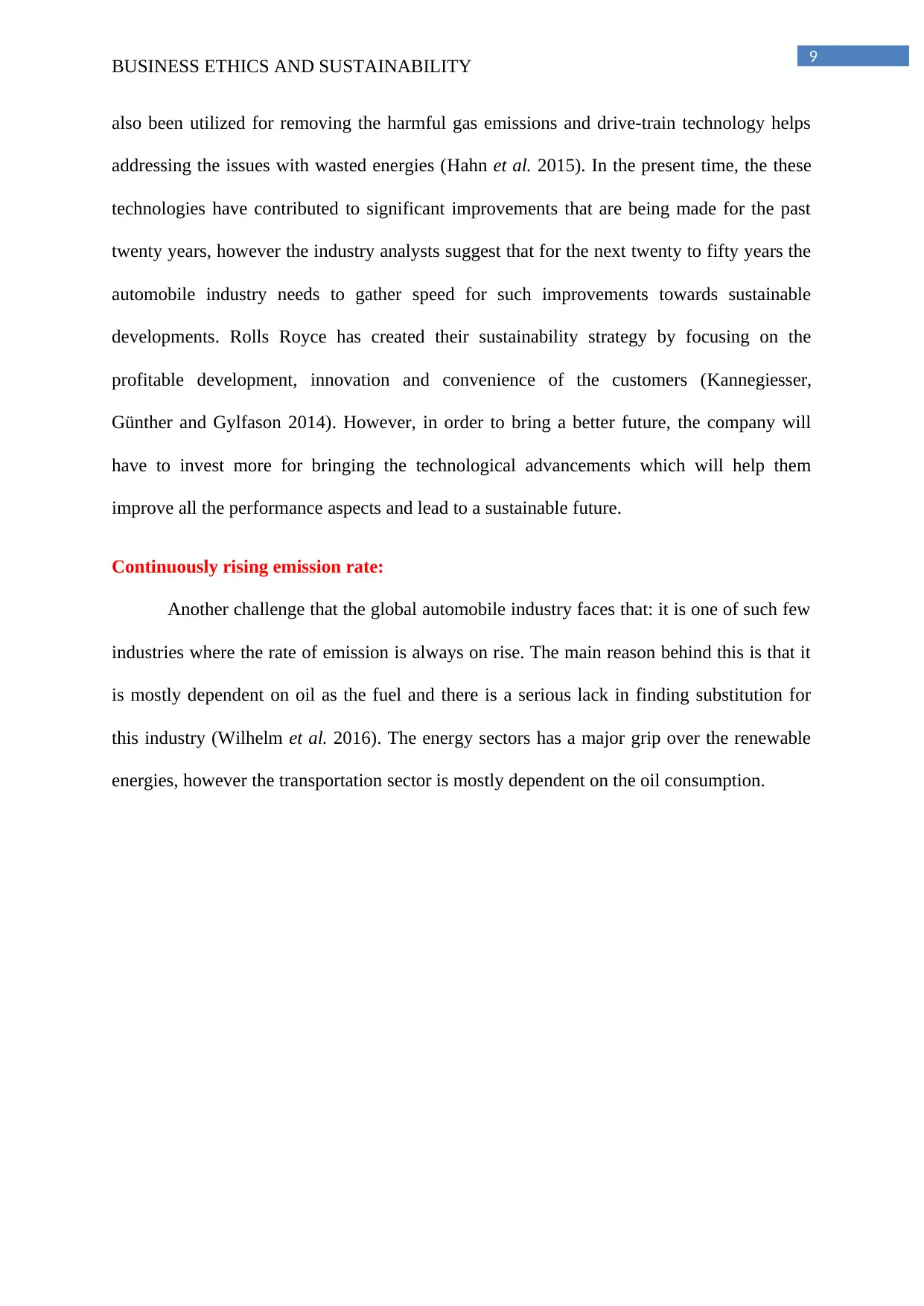
9
BUSINESS ETHICS AND SUSTAINABILITY
also been utilized for removing the harmful gas emissions and drive-train technology helps
addressing the issues with wasted energies (Hahn et al. 2015). In the present time, the these
technologies have contributed to significant improvements that are being made for the past
twenty years, however the industry analysts suggest that for the next twenty to fifty years the
automobile industry needs to gather speed for such improvements towards sustainable
developments. Rolls Royce has created their sustainability strategy by focusing on the
profitable development, innovation and convenience of the customers (Kannegiesser,
Günther and Gylfason 2014). However, in order to bring a better future, the company will
have to invest more for bringing the technological advancements which will help them
improve all the performance aspects and lead to a sustainable future.
Continuously rising emission rate:
Another challenge that the global automobile industry faces that: it is one of such few
industries where the rate of emission is always on rise. The main reason behind this is that it
is mostly dependent on oil as the fuel and there is a serious lack in finding substitution for
this industry (Wilhelm et al. 2016). The energy sectors has a major grip over the renewable
energies, however the transportation sector is mostly dependent on the oil consumption.
BUSINESS ETHICS AND SUSTAINABILITY
also been utilized for removing the harmful gas emissions and drive-train technology helps
addressing the issues with wasted energies (Hahn et al. 2015). In the present time, the these
technologies have contributed to significant improvements that are being made for the past
twenty years, however the industry analysts suggest that for the next twenty to fifty years the
automobile industry needs to gather speed for such improvements towards sustainable
developments. Rolls Royce has created their sustainability strategy by focusing on the
profitable development, innovation and convenience of the customers (Kannegiesser,
Günther and Gylfason 2014). However, in order to bring a better future, the company will
have to invest more for bringing the technological advancements which will help them
improve all the performance aspects and lead to a sustainable future.
Continuously rising emission rate:
Another challenge that the global automobile industry faces that: it is one of such few
industries where the rate of emission is always on rise. The main reason behind this is that it
is mostly dependent on oil as the fuel and there is a serious lack in finding substitution for
this industry (Wilhelm et al. 2016). The energy sectors has a major grip over the renewable
energies, however the transportation sector is mostly dependent on the oil consumption.
Secure Best Marks with AI Grader
Need help grading? Try our AI Grader for instant feedback on your assignments.
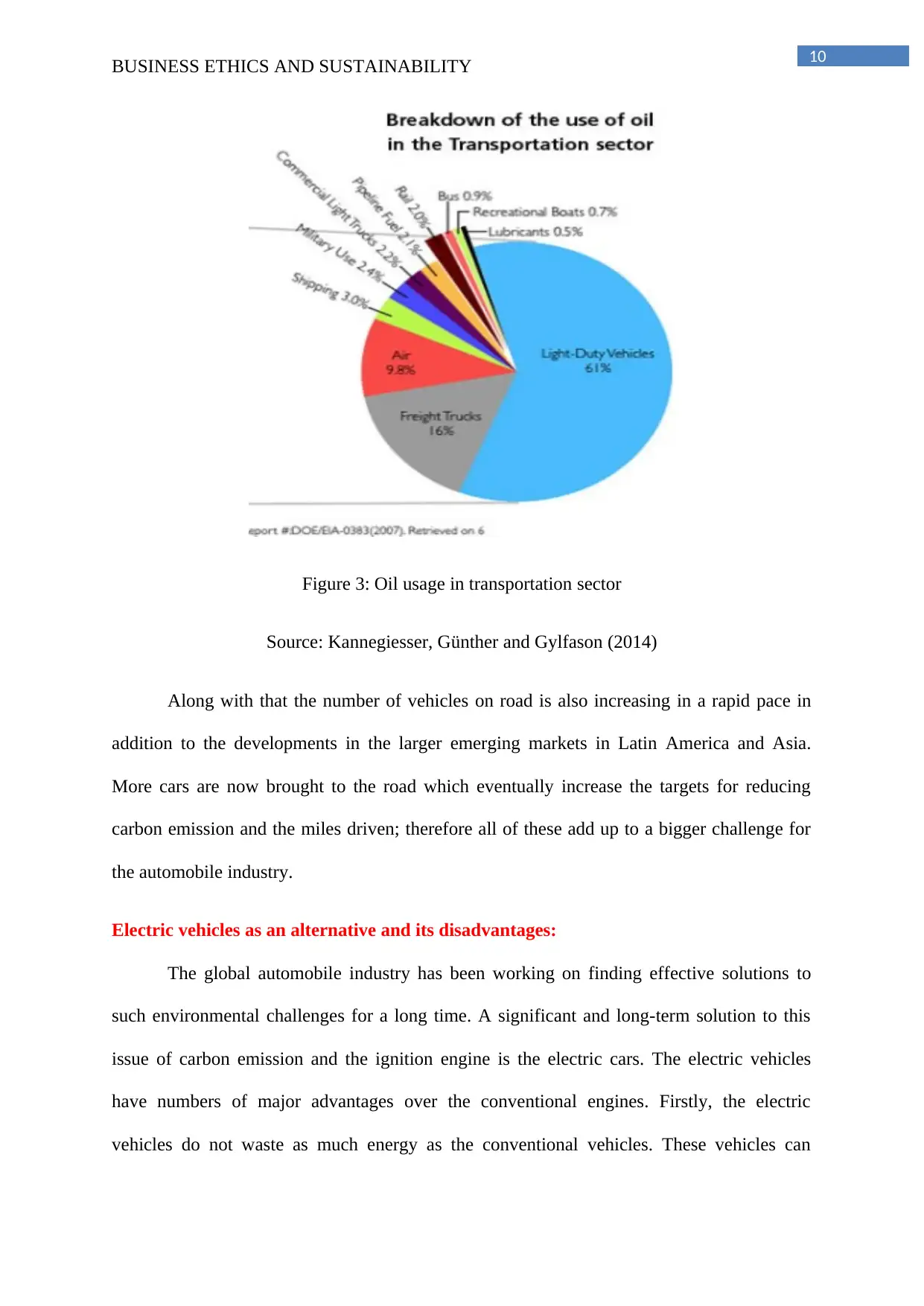
10
BUSINESS ETHICS AND SUSTAINABILITY
Figure 3: Oil usage in transportation sector
Source: Kannegiesser, Günther and Gylfason (2014)
Along with that the number of vehicles on road is also increasing in a rapid pace in
addition to the developments in the larger emerging markets in Latin America and Asia.
More cars are now brought to the road which eventually increase the targets for reducing
carbon emission and the miles driven; therefore all of these add up to a bigger challenge for
the automobile industry.
Electric vehicles as an alternative and its disadvantages:
The global automobile industry has been working on finding effective solutions to
such environmental challenges for a long time. A significant and long-term solution to this
issue of carbon emission and the ignition engine is the electric cars. The electric vehicles
have numbers of major advantages over the conventional engines. Firstly, the electric
vehicles do not waste as much energy as the conventional vehicles. These vehicles can
BUSINESS ETHICS AND SUSTAINABILITY
Figure 3: Oil usage in transportation sector
Source: Kannegiesser, Günther and Gylfason (2014)
Along with that the number of vehicles on road is also increasing in a rapid pace in
addition to the developments in the larger emerging markets in Latin America and Asia.
More cars are now brought to the road which eventually increase the targets for reducing
carbon emission and the miles driven; therefore all of these add up to a bigger challenge for
the automobile industry.
Electric vehicles as an alternative and its disadvantages:
The global automobile industry has been working on finding effective solutions to
such environmental challenges for a long time. A significant and long-term solution to this
issue of carbon emission and the ignition engine is the electric cars. The electric vehicles
have numbers of major advantages over the conventional engines. Firstly, the electric
vehicles do not waste as much energy as the conventional vehicles. These vehicles can

11
BUSINESS ETHICS AND SUSTAINABILITY
convert around 60% energy for powering the cars; therefore it is approximately more three
times efficient than any other conventional engines (Casals et al. 2016). Along with that the
electric cars do not exhaust any fume or any harmful pollutants such as sulphur oxide or
nitrogen oxides. The power of electricity is utilized for recharging these vehicles. The electric
vehicles can also utilize the renewable energies such as solar or wind energy; therefore the
emissions only take place while stemming the manufacturing procedure. However, while the
electric power produced from the conventional energy sources such as gas or coal, there are
still emissions of harmful elements. As suggested by Go, Wahab and Hishamuddin (2015) the
benefit of using the electric vehicles may vary across countries, however there is still doubt
whether the electric cars are providing opportunities considering the environmental
perspective. However mostly it has been a well-accepted fact that the extensive adoption of
the electric vehicles in addition to considering the increased renewable energy generation can
help the industry to achieve its target of reducing carbon emission to a great extent. Other
advantages of using electric cars are that these vehicles reduce the cost of fuel drastically and
they are quiet too (Zokaei et al. 2016). The luxury electric cars are also capable of providing
a nice driving experience. The low cost maintenance has also attracted consumers towards
these cars.
The electric vehicles have been an effective measure for the challenges automobile
industry has been facing for the past few years. However, there are still issues for adapting
the electric vehicles extensively such as its lack of variety and a serious lack in its refuelling
infrastructure. Also most of the electric cars have 100 miles range, even some are lower than
48 before the vehicles need to be recharged. The recharging time is longer than a car takes to
fill with fuel (Ruff 2015). However the hybrid electric vehicles are still dependent on the
internal combustion engines and refuelling. These vehicles cut off emissions to a great extent
and improve the fuel efficiency, but these are still incapable of performing that fully like the
BUSINESS ETHICS AND SUSTAINABILITY
convert around 60% energy for powering the cars; therefore it is approximately more three
times efficient than any other conventional engines (Casals et al. 2016). Along with that the
electric cars do not exhaust any fume or any harmful pollutants such as sulphur oxide or
nitrogen oxides. The power of electricity is utilized for recharging these vehicles. The electric
vehicles can also utilize the renewable energies such as solar or wind energy; therefore the
emissions only take place while stemming the manufacturing procedure. However, while the
electric power produced from the conventional energy sources such as gas or coal, there are
still emissions of harmful elements. As suggested by Go, Wahab and Hishamuddin (2015) the
benefit of using the electric vehicles may vary across countries, however there is still doubt
whether the electric cars are providing opportunities considering the environmental
perspective. However mostly it has been a well-accepted fact that the extensive adoption of
the electric vehicles in addition to considering the increased renewable energy generation can
help the industry to achieve its target of reducing carbon emission to a great extent. Other
advantages of using electric cars are that these vehicles reduce the cost of fuel drastically and
they are quiet too (Zokaei et al. 2016). The luxury electric cars are also capable of providing
a nice driving experience. The low cost maintenance has also attracted consumers towards
these cars.
The electric vehicles have been an effective measure for the challenges automobile
industry has been facing for the past few years. However, there are still issues for adapting
the electric vehicles extensively such as its lack of variety and a serious lack in its refuelling
infrastructure. Also most of the electric cars have 100 miles range, even some are lower than
48 before the vehicles need to be recharged. The recharging time is longer than a car takes to
fill with fuel (Ruff 2015). However the hybrid electric vehicles are still dependent on the
internal combustion engines and refuelling. These vehicles cut off emissions to a great extent
and improve the fuel efficiency, but these are still incapable of performing that fully like the
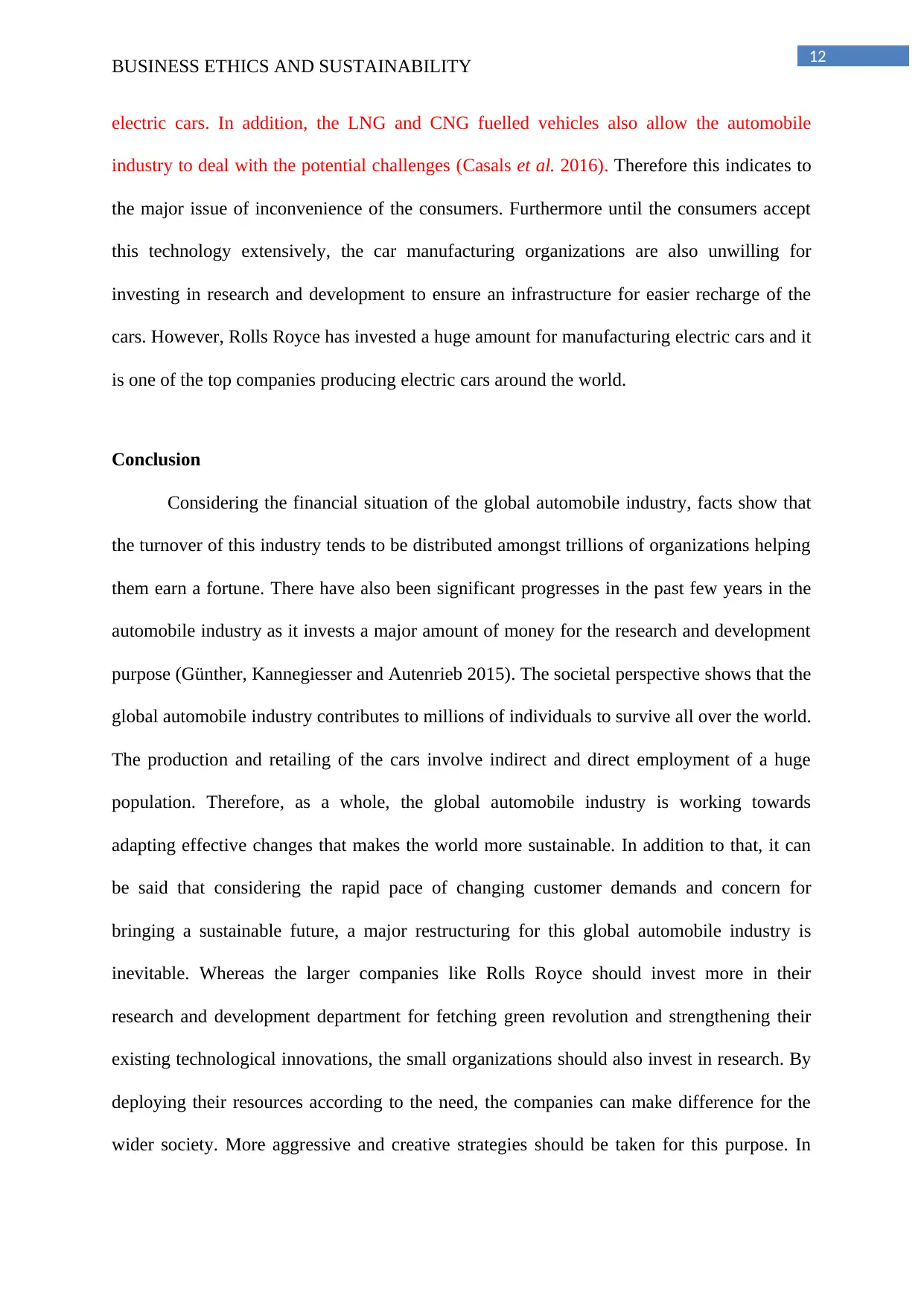
12
BUSINESS ETHICS AND SUSTAINABILITY
electric cars. In addition, the LNG and CNG fuelled vehicles also allow the automobile
industry to deal with the potential challenges (Casals et al. 2016). Therefore this indicates to
the major issue of inconvenience of the consumers. Furthermore until the consumers accept
this technology extensively, the car manufacturing organizations are also unwilling for
investing in research and development to ensure an infrastructure for easier recharge of the
cars. However, Rolls Royce has invested a huge amount for manufacturing electric cars and it
is one of the top companies producing electric cars around the world.
Conclusion
Considering the financial situation of the global automobile industry, facts show that
the turnover of this industry tends to be distributed amongst trillions of organizations helping
them earn a fortune. There have also been significant progresses in the past few years in the
automobile industry as it invests a major amount of money for the research and development
purpose (Günther, Kannegiesser and Autenrieb 2015). The societal perspective shows that the
global automobile industry contributes to millions of individuals to survive all over the world.
The production and retailing of the cars involve indirect and direct employment of a huge
population. Therefore, as a whole, the global automobile industry is working towards
adapting effective changes that makes the world more sustainable. In addition to that, it can
be said that considering the rapid pace of changing customer demands and concern for
bringing a sustainable future, a major restructuring for this global automobile industry is
inevitable. Whereas the larger companies like Rolls Royce should invest more in their
research and development department for fetching green revolution and strengthening their
existing technological innovations, the small organizations should also invest in research. By
deploying their resources according to the need, the companies can make difference for the
wider society. More aggressive and creative strategies should be taken for this purpose. In
BUSINESS ETHICS AND SUSTAINABILITY
electric cars. In addition, the LNG and CNG fuelled vehicles also allow the automobile
industry to deal with the potential challenges (Casals et al. 2016). Therefore this indicates to
the major issue of inconvenience of the consumers. Furthermore until the consumers accept
this technology extensively, the car manufacturing organizations are also unwilling for
investing in research and development to ensure an infrastructure for easier recharge of the
cars. However, Rolls Royce has invested a huge amount for manufacturing electric cars and it
is one of the top companies producing electric cars around the world.
Conclusion
Considering the financial situation of the global automobile industry, facts show that
the turnover of this industry tends to be distributed amongst trillions of organizations helping
them earn a fortune. There have also been significant progresses in the past few years in the
automobile industry as it invests a major amount of money for the research and development
purpose (Günther, Kannegiesser and Autenrieb 2015). The societal perspective shows that the
global automobile industry contributes to millions of individuals to survive all over the world.
The production and retailing of the cars involve indirect and direct employment of a huge
population. Therefore, as a whole, the global automobile industry is working towards
adapting effective changes that makes the world more sustainable. In addition to that, it can
be said that considering the rapid pace of changing customer demands and concern for
bringing a sustainable future, a major restructuring for this global automobile industry is
inevitable. Whereas the larger companies like Rolls Royce should invest more in their
research and development department for fetching green revolution and strengthening their
existing technological innovations, the small organizations should also invest in research. By
deploying their resources according to the need, the companies can make difference for the
wider society. More aggressive and creative strategies should be taken for this purpose. In
Paraphrase This Document
Need a fresh take? Get an instant paraphrase of this document with our AI Paraphraser

13
BUSINESS ETHICS AND SUSTAINABILITY
addition to that, it is an unavoidable fact that the technological innovations for dealing with
potential challenges of the automobile industry will cause higher costs according to the
customer demands (Brook and Pagnanelli 2014). Therefore larger companies such as Rolls
Royce should emphasise on design, manufacture and market their vehicles in accordance to
the consumer demand as well. The organization should also design their strategies
considering the long term betterment of the wider community.
Recommendations from an Ethics and Sustainability Consultant:
Rolls Royce has already been identified as one of the leaders in sustainable business
in automobile industry, especially in the defence and aerospace sector. It has been indicated
in the company reports that it has been able to become a leading standard indicator for the
sustainable business in automobile industry. However, the organization can also adapt some
new policies for next fifty years:
Electric cars have already been on the roads for quite some time. Rolls Royce has also
manufactured electric cars. However, as discussed before, the main issue with electric
cars is that even if these cars reduce the consumption of oil to a great extent, it
increases the gas or white coal consumption (Casals et al. 2016). Therefore Rolls
Royce can invest more in researching for bringing new technologies that will not
affect the coal or gas consumption. The water powered or hydrogen fuels have been
talked about a lot in recent times, but these have not been materialized within greater
context. As storing and transporting the hydrogen gas is difficult, it brings unusual
concerns for using it as a fuel for cars. Many theorists even indicated that it is
doubtful that the automobile industry may not switch to hydrogen fuel anytime soon
as it is way too much costly for consumers (Guo and Zhao 2015). Therefore, Rolls
Royce can invest more in the research for developing new strategies to bring
BUSINESS ETHICS AND SUSTAINABILITY
addition to that, it is an unavoidable fact that the technological innovations for dealing with
potential challenges of the automobile industry will cause higher costs according to the
customer demands (Brook and Pagnanelli 2014). Therefore larger companies such as Rolls
Royce should emphasise on design, manufacture and market their vehicles in accordance to
the consumer demand as well. The organization should also design their strategies
considering the long term betterment of the wider community.
Recommendations from an Ethics and Sustainability Consultant:
Rolls Royce has already been identified as one of the leaders in sustainable business
in automobile industry, especially in the defence and aerospace sector. It has been indicated
in the company reports that it has been able to become a leading standard indicator for the
sustainable business in automobile industry. However, the organization can also adapt some
new policies for next fifty years:
Electric cars have already been on the roads for quite some time. Rolls Royce has also
manufactured electric cars. However, as discussed before, the main issue with electric
cars is that even if these cars reduce the consumption of oil to a great extent, it
increases the gas or white coal consumption (Casals et al. 2016). Therefore Rolls
Royce can invest more in researching for bringing new technologies that will not
affect the coal or gas consumption. The water powered or hydrogen fuels have been
talked about a lot in recent times, but these have not been materialized within greater
context. As storing and transporting the hydrogen gas is difficult, it brings unusual
concerns for using it as a fuel for cars. Many theorists even indicated that it is
doubtful that the automobile industry may not switch to hydrogen fuel anytime soon
as it is way too much costly for consumers (Guo and Zhao 2015). Therefore, Rolls
Royce can invest more in the research for developing new strategies to bring
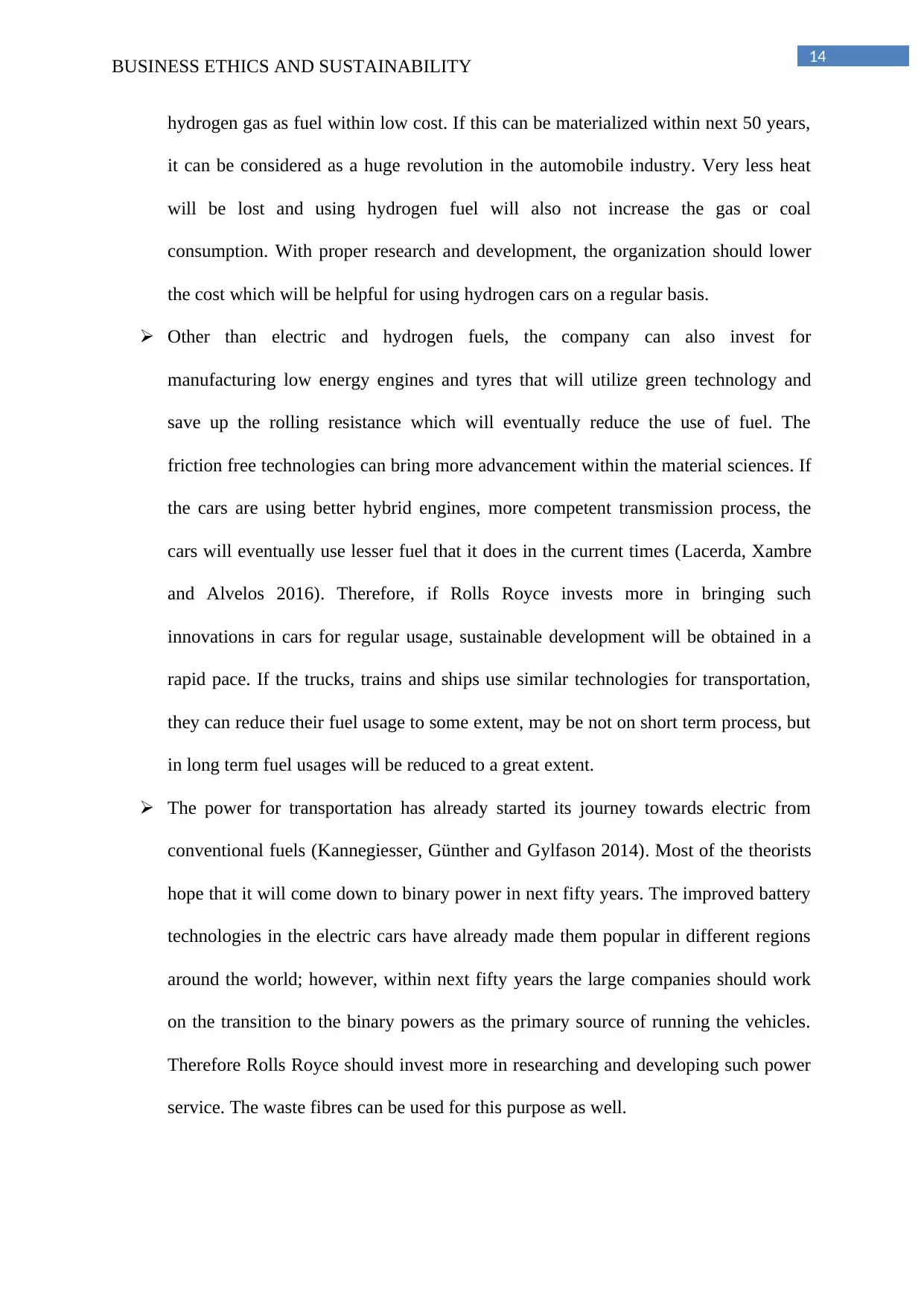
14
BUSINESS ETHICS AND SUSTAINABILITY
hydrogen gas as fuel within low cost. If this can be materialized within next 50 years,
it can be considered as a huge revolution in the automobile industry. Very less heat
will be lost and using hydrogen fuel will also not increase the gas or coal
consumption. With proper research and development, the organization should lower
the cost which will be helpful for using hydrogen cars on a regular basis.
Other than electric and hydrogen fuels, the company can also invest for
manufacturing low energy engines and tyres that will utilize green technology and
save up the rolling resistance which will eventually reduce the use of fuel. The
friction free technologies can bring more advancement within the material sciences. If
the cars are using better hybrid engines, more competent transmission process, the
cars will eventually use lesser fuel that it does in the current times (Lacerda, Xambre
and Alvelos 2016). Therefore, if Rolls Royce invests more in bringing such
innovations in cars for regular usage, sustainable development will be obtained in a
rapid pace. If the trucks, trains and ships use similar technologies for transportation,
they can reduce their fuel usage to some extent, may be not on short term process, but
in long term fuel usages will be reduced to a great extent.
The power for transportation has already started its journey towards electric from
conventional fuels (Kannegiesser, Günther and Gylfason 2014). Most of the theorists
hope that it will come down to binary power in next fifty years. The improved battery
technologies in the electric cars have already made them popular in different regions
around the world; however, within next fifty years the large companies should work
on the transition to the binary powers as the primary source of running the vehicles.
Therefore Rolls Royce should invest more in researching and developing such power
service. The waste fibres can be used for this purpose as well.
BUSINESS ETHICS AND SUSTAINABILITY
hydrogen gas as fuel within low cost. If this can be materialized within next 50 years,
it can be considered as a huge revolution in the automobile industry. Very less heat
will be lost and using hydrogen fuel will also not increase the gas or coal
consumption. With proper research and development, the organization should lower
the cost which will be helpful for using hydrogen cars on a regular basis.
Other than electric and hydrogen fuels, the company can also invest for
manufacturing low energy engines and tyres that will utilize green technology and
save up the rolling resistance which will eventually reduce the use of fuel. The
friction free technologies can bring more advancement within the material sciences. If
the cars are using better hybrid engines, more competent transmission process, the
cars will eventually use lesser fuel that it does in the current times (Lacerda, Xambre
and Alvelos 2016). Therefore, if Rolls Royce invests more in bringing such
innovations in cars for regular usage, sustainable development will be obtained in a
rapid pace. If the trucks, trains and ships use similar technologies for transportation,
they can reduce their fuel usage to some extent, may be not on short term process, but
in long term fuel usages will be reduced to a great extent.
The power for transportation has already started its journey towards electric from
conventional fuels (Kannegiesser, Günther and Gylfason 2014). Most of the theorists
hope that it will come down to binary power in next fifty years. The improved battery
technologies in the electric cars have already made them popular in different regions
around the world; however, within next fifty years the large companies should work
on the transition to the binary powers as the primary source of running the vehicles.
Therefore Rolls Royce should invest more in researching and developing such power
service. The waste fibres can be used for this purpose as well.
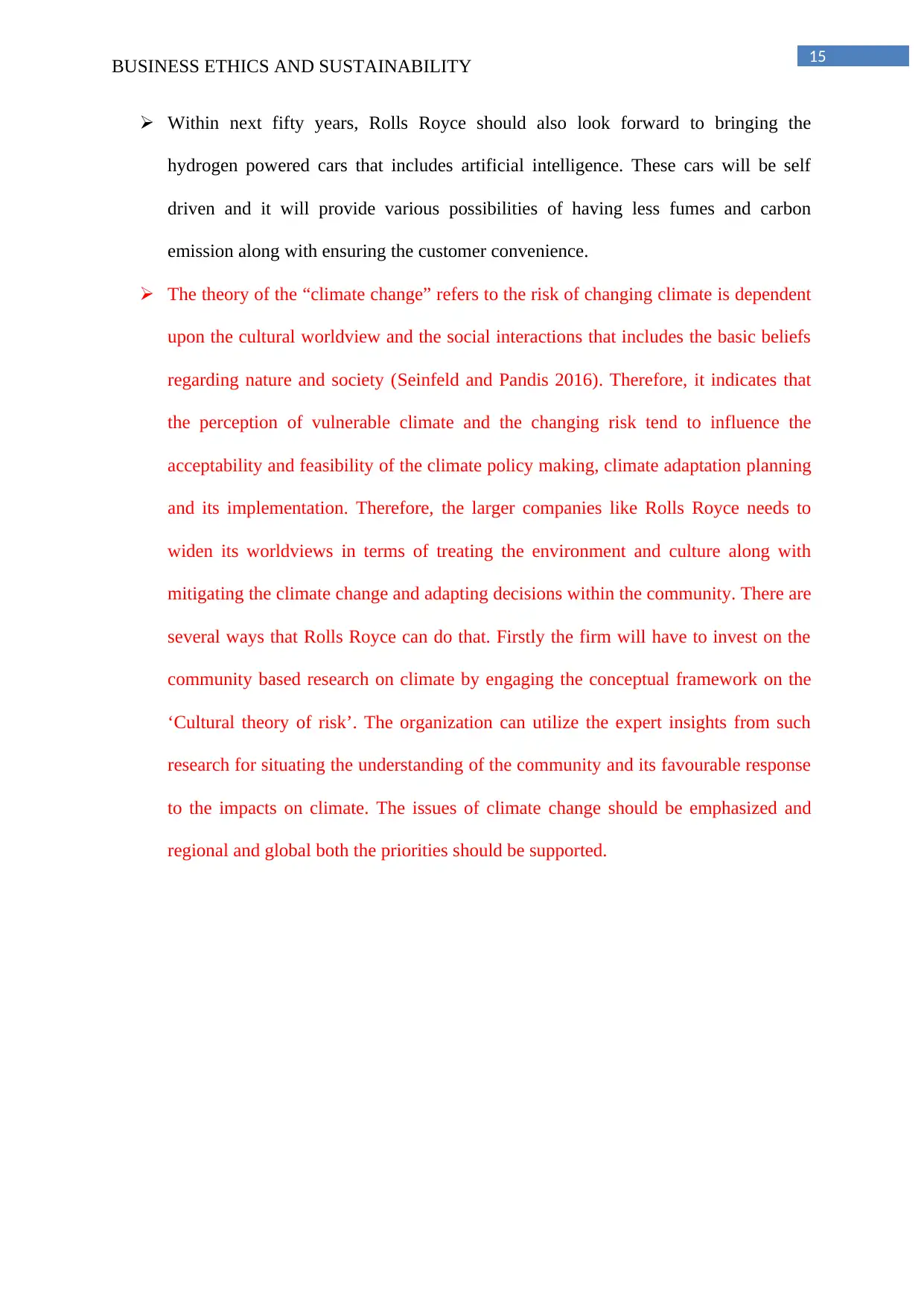
15
BUSINESS ETHICS AND SUSTAINABILITY
Within next fifty years, Rolls Royce should also look forward to bringing the
hydrogen powered cars that includes artificial intelligence. These cars will be self
driven and it will provide various possibilities of having less fumes and carbon
emission along with ensuring the customer convenience.
The theory of the “climate change” refers to the risk of changing climate is dependent
upon the cultural worldview and the social interactions that includes the basic beliefs
regarding nature and society (Seinfeld and Pandis 2016). Therefore, it indicates that
the perception of vulnerable climate and the changing risk tend to influence the
acceptability and feasibility of the climate policy making, climate adaptation planning
and its implementation. Therefore, the larger companies like Rolls Royce needs to
widen its worldviews in terms of treating the environment and culture along with
mitigating the climate change and adapting decisions within the community. There are
several ways that Rolls Royce can do that. Firstly the firm will have to invest on the
community based research on climate by engaging the conceptual framework on the
‘Cultural theory of risk’. The organization can utilize the expert insights from such
research for situating the understanding of the community and its favourable response
to the impacts on climate. The issues of climate change should be emphasized and
regional and global both the priorities should be supported.
BUSINESS ETHICS AND SUSTAINABILITY
Within next fifty years, Rolls Royce should also look forward to bringing the
hydrogen powered cars that includes artificial intelligence. These cars will be self
driven and it will provide various possibilities of having less fumes and carbon
emission along with ensuring the customer convenience.
The theory of the “climate change” refers to the risk of changing climate is dependent
upon the cultural worldview and the social interactions that includes the basic beliefs
regarding nature and society (Seinfeld and Pandis 2016). Therefore, it indicates that
the perception of vulnerable climate and the changing risk tend to influence the
acceptability and feasibility of the climate policy making, climate adaptation planning
and its implementation. Therefore, the larger companies like Rolls Royce needs to
widen its worldviews in terms of treating the environment and culture along with
mitigating the climate change and adapting decisions within the community. There are
several ways that Rolls Royce can do that. Firstly the firm will have to invest on the
community based research on climate by engaging the conceptual framework on the
‘Cultural theory of risk’. The organization can utilize the expert insights from such
research for situating the understanding of the community and its favourable response
to the impacts on climate. The issues of climate change should be emphasized and
regional and global both the priorities should be supported.
Secure Best Marks with AI Grader
Need help grading? Try our AI Grader for instant feedback on your assignments.
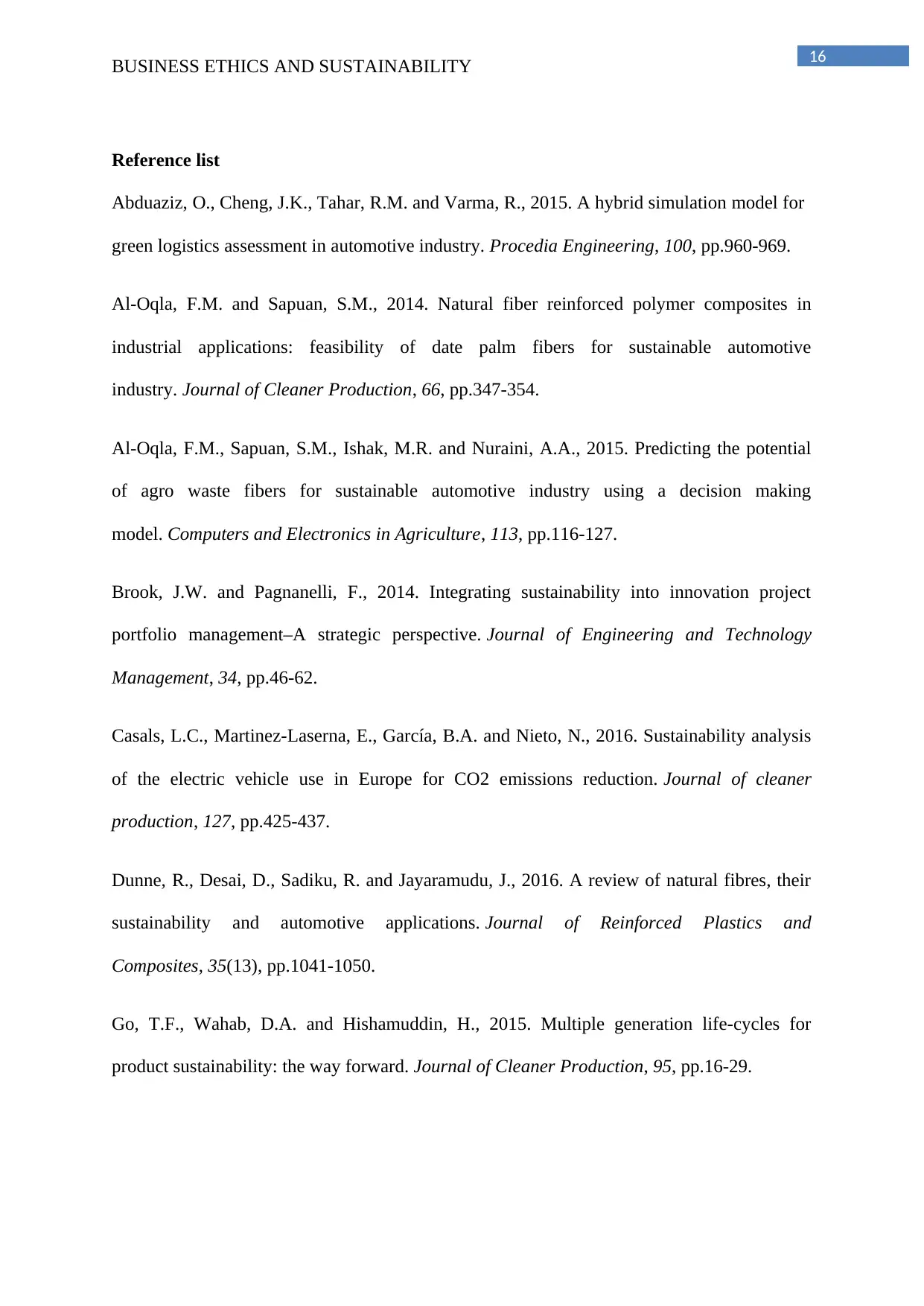
16
BUSINESS ETHICS AND SUSTAINABILITY
Reference list
Abduaziz, O., Cheng, J.K., Tahar, R.M. and Varma, R., 2015. A hybrid simulation model for
green logistics assessment in automotive industry. Procedia Engineering, 100, pp.960-969.
Al-Oqla, F.M. and Sapuan, S.M., 2014. Natural fiber reinforced polymer composites in
industrial applications: feasibility of date palm fibers for sustainable automotive
industry. Journal of Cleaner Production, 66, pp.347-354.
Al-Oqla, F.M., Sapuan, S.M., Ishak, M.R. and Nuraini, A.A., 2015. Predicting the potential
of agro waste fibers for sustainable automotive industry using a decision making
model. Computers and Electronics in Agriculture, 113, pp.116-127.
Brook, J.W. and Pagnanelli, F., 2014. Integrating sustainability into innovation project
portfolio management–A strategic perspective. Journal of Engineering and Technology
Management, 34, pp.46-62.
Casals, L.C., Martinez-Laserna, E., García, B.A. and Nieto, N., 2016. Sustainability analysis
of the electric vehicle use in Europe for CO2 emissions reduction. Journal of cleaner
production, 127, pp.425-437.
Dunne, R., Desai, D., Sadiku, R. and Jayaramudu, J., 2016. A review of natural fibres, their
sustainability and automotive applications. Journal of Reinforced Plastics and
Composites, 35(13), pp.1041-1050.
Go, T.F., Wahab, D.A. and Hishamuddin, H., 2015. Multiple generation life-cycles for
product sustainability: the way forward. Journal of Cleaner Production, 95, pp.16-29.
BUSINESS ETHICS AND SUSTAINABILITY
Reference list
Abduaziz, O., Cheng, J.K., Tahar, R.M. and Varma, R., 2015. A hybrid simulation model for
green logistics assessment in automotive industry. Procedia Engineering, 100, pp.960-969.
Al-Oqla, F.M. and Sapuan, S.M., 2014. Natural fiber reinforced polymer composites in
industrial applications: feasibility of date palm fibers for sustainable automotive
industry. Journal of Cleaner Production, 66, pp.347-354.
Al-Oqla, F.M., Sapuan, S.M., Ishak, M.R. and Nuraini, A.A., 2015. Predicting the potential
of agro waste fibers for sustainable automotive industry using a decision making
model. Computers and Electronics in Agriculture, 113, pp.116-127.
Brook, J.W. and Pagnanelli, F., 2014. Integrating sustainability into innovation project
portfolio management–A strategic perspective. Journal of Engineering and Technology
Management, 34, pp.46-62.
Casals, L.C., Martinez-Laserna, E., García, B.A. and Nieto, N., 2016. Sustainability analysis
of the electric vehicle use in Europe for CO2 emissions reduction. Journal of cleaner
production, 127, pp.425-437.
Dunne, R., Desai, D., Sadiku, R. and Jayaramudu, J., 2016. A review of natural fibres, their
sustainability and automotive applications. Journal of Reinforced Plastics and
Composites, 35(13), pp.1041-1050.
Go, T.F., Wahab, D.A. and Hishamuddin, H., 2015. Multiple generation life-cycles for
product sustainability: the way forward. Journal of Cleaner Production, 95, pp.16-29.
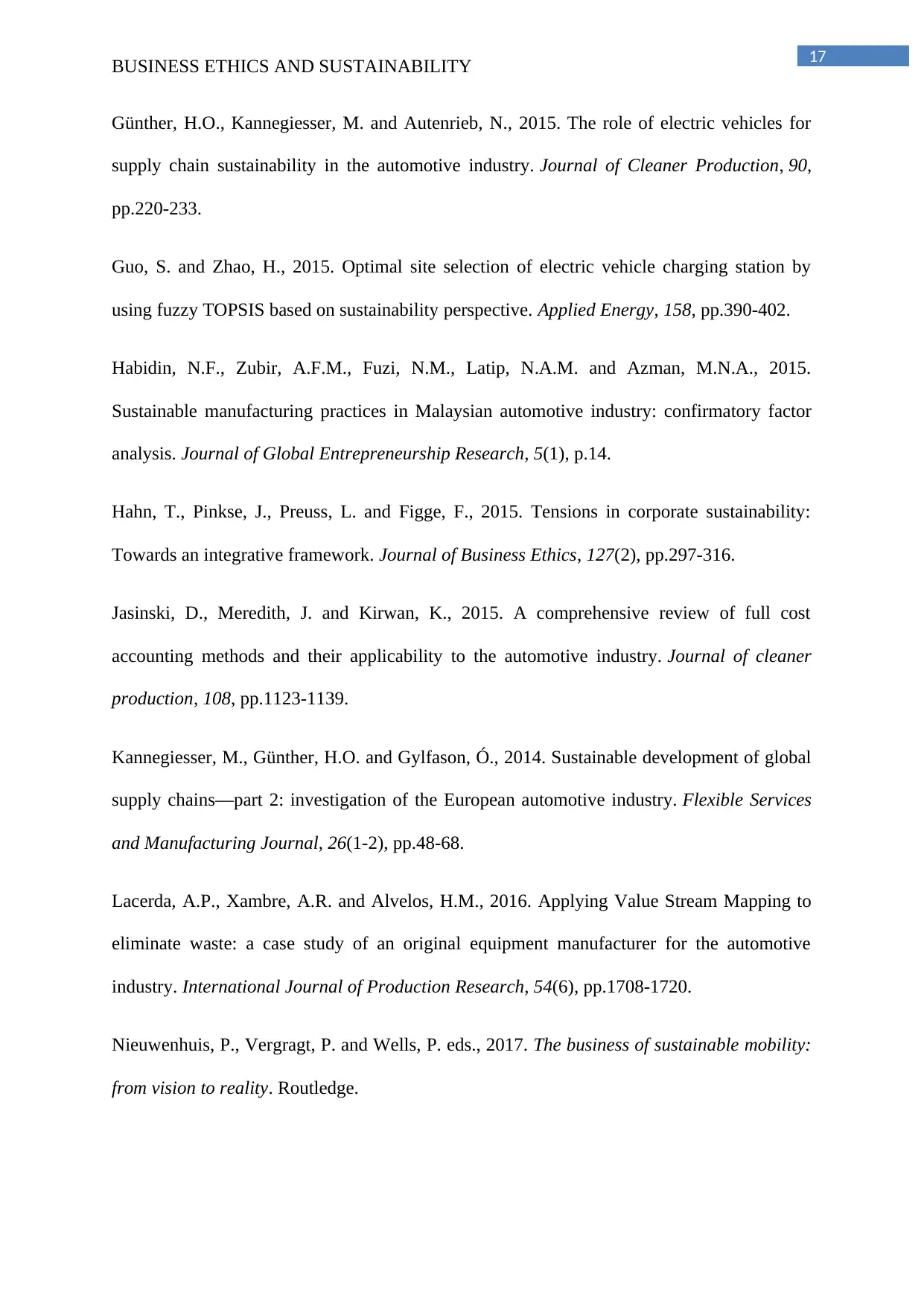
17
BUSINESS ETHICS AND SUSTAINABILITY
Günther, H.O., Kannegiesser, M. and Autenrieb, N., 2015. The role of electric vehicles for
supply chain sustainability in the automotive industry. Journal of Cleaner Production, 90,
pp.220-233.
Guo, S. and Zhao, H., 2015. Optimal site selection of electric vehicle charging station by
using fuzzy TOPSIS based on sustainability perspective. Applied Energy, 158, pp.390-402.
Habidin, N.F., Zubir, A.F.M., Fuzi, N.M., Latip, N.A.M. and Azman, M.N.A., 2015.
Sustainable manufacturing practices in Malaysian automotive industry: confirmatory factor
analysis. Journal of Global Entrepreneurship Research, 5(1), p.14.
Hahn, T., Pinkse, J., Preuss, L. and Figge, F., 2015. Tensions in corporate sustainability:
Towards an integrative framework. Journal of Business Ethics, 127(2), pp.297-316.
Jasinski, D., Meredith, J. and Kirwan, K., 2015. A comprehensive review of full cost
accounting methods and their applicability to the automotive industry. Journal of cleaner
production, 108, pp.1123-1139.
Kannegiesser, M., Günther, H.O. and Gylfason, Ó., 2014. Sustainable development of global
supply chains—part 2: investigation of the European automotive industry. Flexible Services
and Manufacturing Journal, 26(1-2), pp.48-68.
Lacerda, A.P., Xambre, A.R. and Alvelos, H.M., 2016. Applying Value Stream Mapping to
eliminate waste: a case study of an original equipment manufacturer for the automotive
industry. International Journal of Production Research, 54(6), pp.1708-1720.
Nieuwenhuis, P., Vergragt, P. and Wells, P. eds., 2017. The business of sustainable mobility:
from vision to reality. Routledge.
BUSINESS ETHICS AND SUSTAINABILITY
Günther, H.O., Kannegiesser, M. and Autenrieb, N., 2015. The role of electric vehicles for
supply chain sustainability in the automotive industry. Journal of Cleaner Production, 90,
pp.220-233.
Guo, S. and Zhao, H., 2015. Optimal site selection of electric vehicle charging station by
using fuzzy TOPSIS based on sustainability perspective. Applied Energy, 158, pp.390-402.
Habidin, N.F., Zubir, A.F.M., Fuzi, N.M., Latip, N.A.M. and Azman, M.N.A., 2015.
Sustainable manufacturing practices in Malaysian automotive industry: confirmatory factor
analysis. Journal of Global Entrepreneurship Research, 5(1), p.14.
Hahn, T., Pinkse, J., Preuss, L. and Figge, F., 2015. Tensions in corporate sustainability:
Towards an integrative framework. Journal of Business Ethics, 127(2), pp.297-316.
Jasinski, D., Meredith, J. and Kirwan, K., 2015. A comprehensive review of full cost
accounting methods and their applicability to the automotive industry. Journal of cleaner
production, 108, pp.1123-1139.
Kannegiesser, M., Günther, H.O. and Gylfason, Ó., 2014. Sustainable development of global
supply chains—part 2: investigation of the European automotive industry. Flexible Services
and Manufacturing Journal, 26(1-2), pp.48-68.
Lacerda, A.P., Xambre, A.R. and Alvelos, H.M., 2016. Applying Value Stream Mapping to
eliminate waste: a case study of an original equipment manufacturer for the automotive
industry. International Journal of Production Research, 54(6), pp.1708-1720.
Nieuwenhuis, P., Vergragt, P. and Wells, P. eds., 2017. The business of sustainable mobility:
from vision to reality. Routledge.
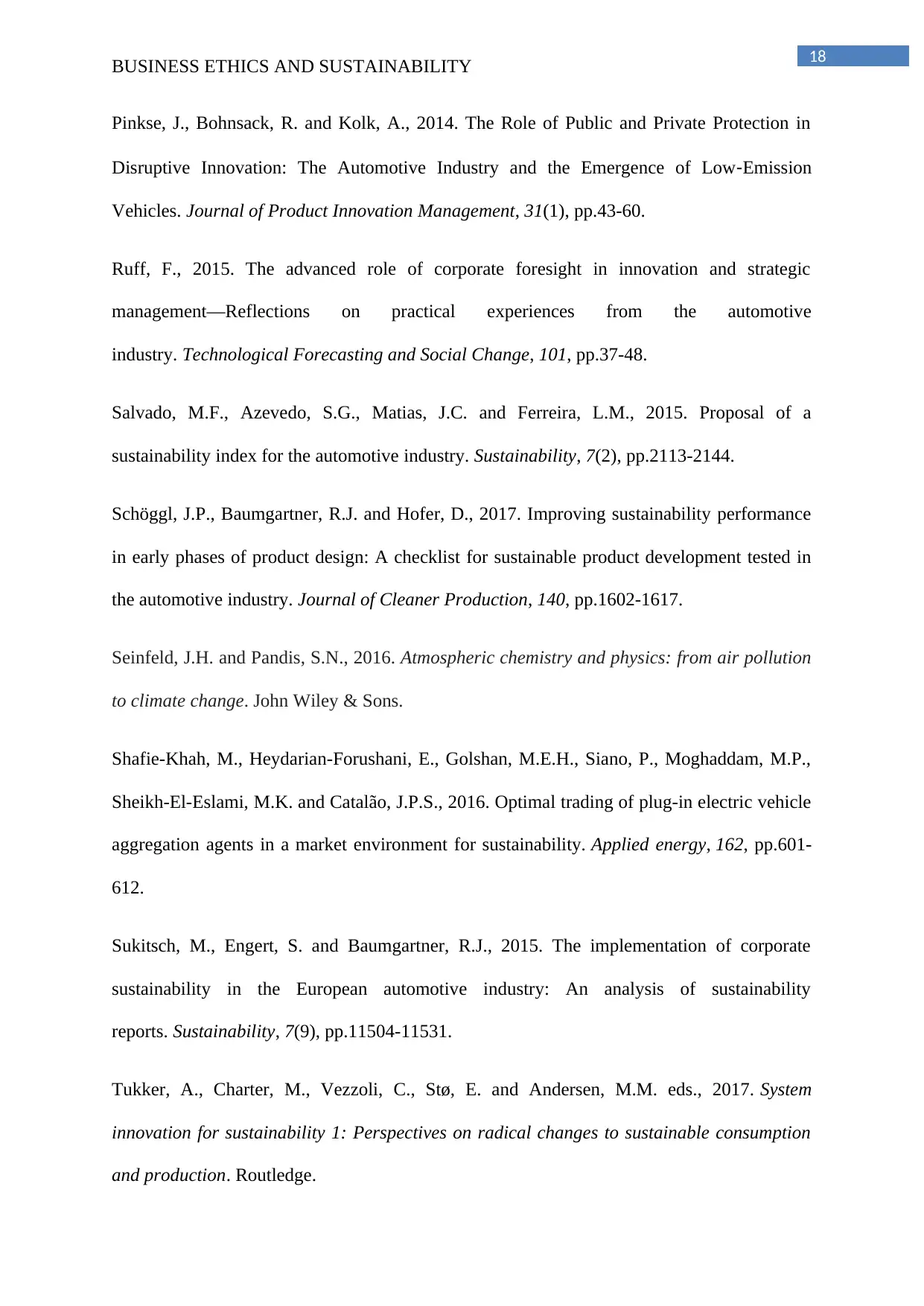
18
BUSINESS ETHICS AND SUSTAINABILITY
Pinkse, J., Bohnsack, R. and Kolk, A., 2014. The Role of Public and Private Protection in
Disruptive Innovation: The Automotive Industry and the Emergence of Low‐Emission
Vehicles. Journal of Product Innovation Management, 31(1), pp.43-60.
Ruff, F., 2015. The advanced role of corporate foresight in innovation and strategic
management—Reflections on practical experiences from the automotive
industry. Technological Forecasting and Social Change, 101, pp.37-48.
Salvado, M.F., Azevedo, S.G., Matias, J.C. and Ferreira, L.M., 2015. Proposal of a
sustainability index for the automotive industry. Sustainability, 7(2), pp.2113-2144.
Schöggl, J.P., Baumgartner, R.J. and Hofer, D., 2017. Improving sustainability performance
in early phases of product design: A checklist for sustainable product development tested in
the automotive industry. Journal of Cleaner Production, 140, pp.1602-1617.
Seinfeld, J.H. and Pandis, S.N., 2016. Atmospheric chemistry and physics: from air pollution
to climate change. John Wiley & Sons.
Shafie-Khah, M., Heydarian-Forushani, E., Golshan, M.E.H., Siano, P., Moghaddam, M.P.,
Sheikh-El-Eslami, M.K. and Catalão, J.P.S., 2016. Optimal trading of plug-in electric vehicle
aggregation agents in a market environment for sustainability. Applied energy, 162, pp.601-
612.
Sukitsch, M., Engert, S. and Baumgartner, R.J., 2015. The implementation of corporate
sustainability in the European automotive industry: An analysis of sustainability
reports. Sustainability, 7(9), pp.11504-11531.
Tukker, A., Charter, M., Vezzoli, C., Stø, E. and Andersen, M.M. eds., 2017. System
innovation for sustainability 1: Perspectives on radical changes to sustainable consumption
and production. Routledge.
BUSINESS ETHICS AND SUSTAINABILITY
Pinkse, J., Bohnsack, R. and Kolk, A., 2014. The Role of Public and Private Protection in
Disruptive Innovation: The Automotive Industry and the Emergence of Low‐Emission
Vehicles. Journal of Product Innovation Management, 31(1), pp.43-60.
Ruff, F., 2015. The advanced role of corporate foresight in innovation and strategic
management—Reflections on practical experiences from the automotive
industry. Technological Forecasting and Social Change, 101, pp.37-48.
Salvado, M.F., Azevedo, S.G., Matias, J.C. and Ferreira, L.M., 2015. Proposal of a
sustainability index for the automotive industry. Sustainability, 7(2), pp.2113-2144.
Schöggl, J.P., Baumgartner, R.J. and Hofer, D., 2017. Improving sustainability performance
in early phases of product design: A checklist for sustainable product development tested in
the automotive industry. Journal of Cleaner Production, 140, pp.1602-1617.
Seinfeld, J.H. and Pandis, S.N., 2016. Atmospheric chemistry and physics: from air pollution
to climate change. John Wiley & Sons.
Shafie-Khah, M., Heydarian-Forushani, E., Golshan, M.E.H., Siano, P., Moghaddam, M.P.,
Sheikh-El-Eslami, M.K. and Catalão, J.P.S., 2016. Optimal trading of plug-in electric vehicle
aggregation agents in a market environment for sustainability. Applied energy, 162, pp.601-
612.
Sukitsch, M., Engert, S. and Baumgartner, R.J., 2015. The implementation of corporate
sustainability in the European automotive industry: An analysis of sustainability
reports. Sustainability, 7(9), pp.11504-11531.
Tukker, A., Charter, M., Vezzoli, C., Stø, E. and Andersen, M.M. eds., 2017. System
innovation for sustainability 1: Perspectives on radical changes to sustainable consumption
and production. Routledge.
Paraphrase This Document
Need a fresh take? Get an instant paraphrase of this document with our AI Paraphraser
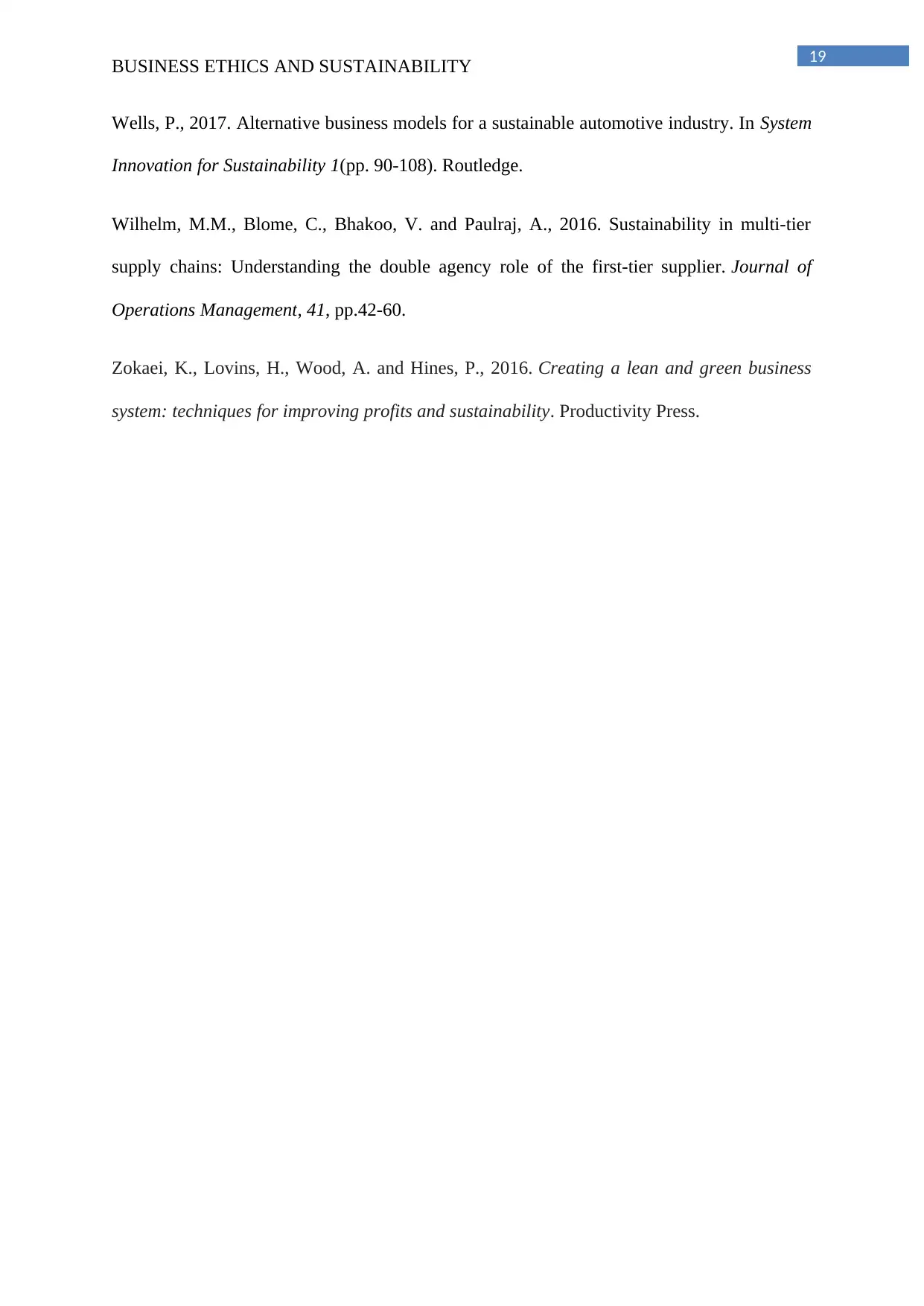
19
BUSINESS ETHICS AND SUSTAINABILITY
Wells, P., 2017. Alternative business models for a sustainable automotive industry. In System
Innovation for Sustainability 1(pp. 90-108). Routledge.
Wilhelm, M.M., Blome, C., Bhakoo, V. and Paulraj, A., 2016. Sustainability in multi-tier
supply chains: Understanding the double agency role of the first-tier supplier. Journal of
Operations Management, 41, pp.42-60.
Zokaei, K., Lovins, H., Wood, A. and Hines, P., 2016. Creating a lean and green business
system: techniques for improving profits and sustainability. Productivity Press.
BUSINESS ETHICS AND SUSTAINABILITY
Wells, P., 2017. Alternative business models for a sustainable automotive industry. In System
Innovation for Sustainability 1(pp. 90-108). Routledge.
Wilhelm, M.M., Blome, C., Bhakoo, V. and Paulraj, A., 2016. Sustainability in multi-tier
supply chains: Understanding the double agency role of the first-tier supplier. Journal of
Operations Management, 41, pp.42-60.
Zokaei, K., Lovins, H., Wood, A. and Hines, P., 2016. Creating a lean and green business
system: techniques for improving profits and sustainability. Productivity Press.
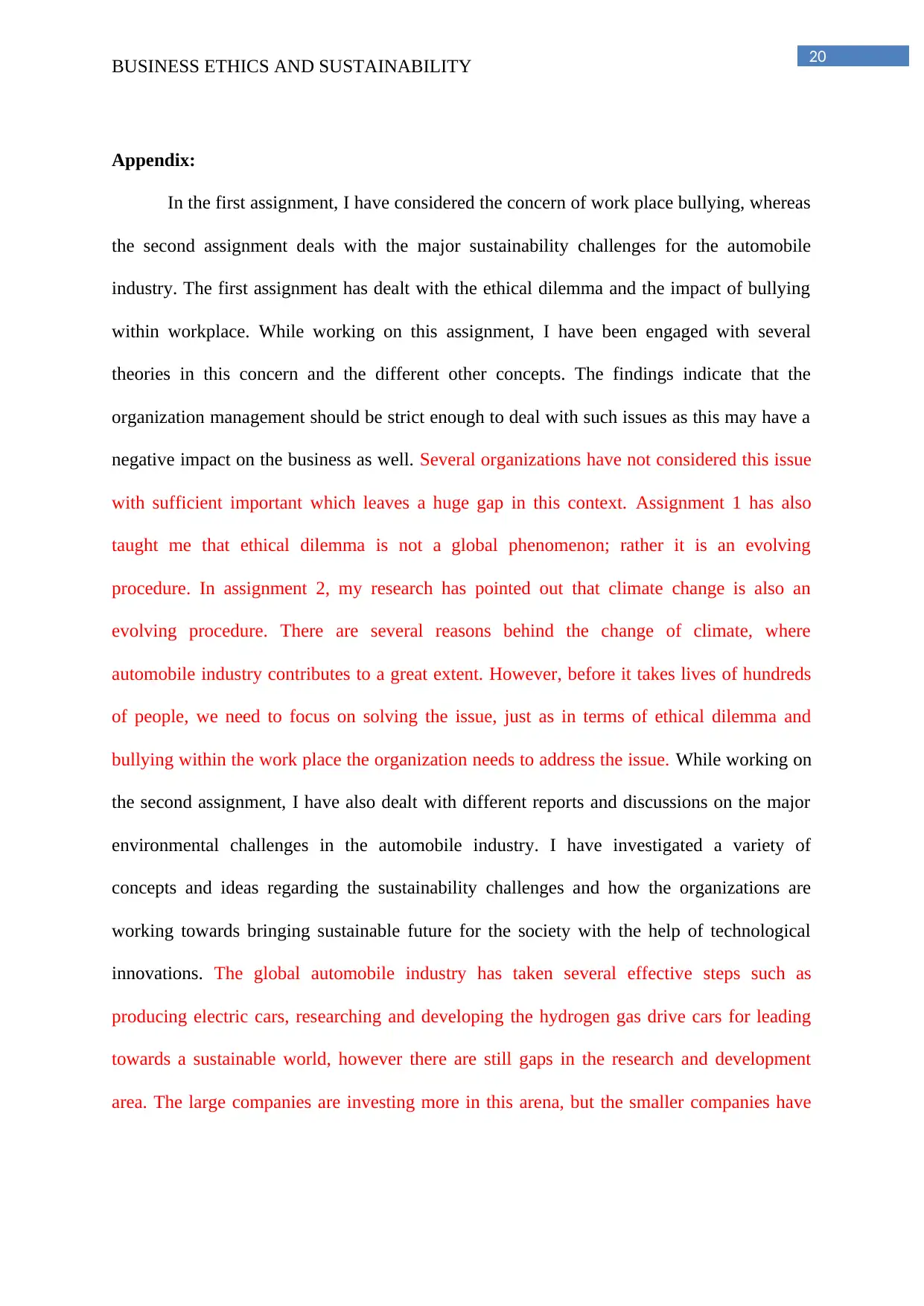
20
BUSINESS ETHICS AND SUSTAINABILITY
Appendix:
In the first assignment, I have considered the concern of work place bullying, whereas
the second assignment deals with the major sustainability challenges for the automobile
industry. The first assignment has dealt with the ethical dilemma and the impact of bullying
within workplace. While working on this assignment, I have been engaged with several
theories in this concern and the different other concepts. The findings indicate that the
organization management should be strict enough to deal with such issues as this may have a
negative impact on the business as well. Several organizations have not considered this issue
with sufficient important which leaves a huge gap in this context. Assignment 1 has also
taught me that ethical dilemma is not a global phenomenon; rather it is an evolving
procedure. In assignment 2, my research has pointed out that climate change is also an
evolving procedure. There are several reasons behind the change of climate, where
automobile industry contributes to a great extent. However, before it takes lives of hundreds
of people, we need to focus on solving the issue, just as in terms of ethical dilemma and
bullying within the work place the organization needs to address the issue. While working on
the second assignment, I have also dealt with different reports and discussions on the major
environmental challenges in the automobile industry. I have investigated a variety of
concepts and ideas regarding the sustainability challenges and how the organizations are
working towards bringing sustainable future for the society with the help of technological
innovations. The global automobile industry has taken several effective steps such as
producing electric cars, researching and developing the hydrogen gas drive cars for leading
towards a sustainable world, however there are still gaps in the research and development
area. The large companies are investing more in this arena, but the smaller companies have
BUSINESS ETHICS AND SUSTAINABILITY
Appendix:
In the first assignment, I have considered the concern of work place bullying, whereas
the second assignment deals with the major sustainability challenges for the automobile
industry. The first assignment has dealt with the ethical dilemma and the impact of bullying
within workplace. While working on this assignment, I have been engaged with several
theories in this concern and the different other concepts. The findings indicate that the
organization management should be strict enough to deal with such issues as this may have a
negative impact on the business as well. Several organizations have not considered this issue
with sufficient important which leaves a huge gap in this context. Assignment 1 has also
taught me that ethical dilemma is not a global phenomenon; rather it is an evolving
procedure. In assignment 2, my research has pointed out that climate change is also an
evolving procedure. There are several reasons behind the change of climate, where
automobile industry contributes to a great extent. However, before it takes lives of hundreds
of people, we need to focus on solving the issue, just as in terms of ethical dilemma and
bullying within the work place the organization needs to address the issue. While working on
the second assignment, I have also dealt with different reports and discussions on the major
environmental challenges in the automobile industry. I have investigated a variety of
concepts and ideas regarding the sustainability challenges and how the organizations are
working towards bringing sustainable future for the society with the help of technological
innovations. The global automobile industry has taken several effective steps such as
producing electric cars, researching and developing the hydrogen gas drive cars for leading
towards a sustainable world, however there are still gaps in the research and development
area. The large companies are investing more in this arena, but the smaller companies have

21
BUSINESS ETHICS AND SUSTAINABILITY
not done much. Therefore it is necessary to look into this matter. Also the cars with
alternative fuels are more expensive; the customers may not opt for such vehicles as well.
BUSINESS ETHICS AND SUSTAINABILITY
not done much. Therefore it is necessary to look into this matter. Also the cars with
alternative fuels are more expensive; the customers may not opt for such vehicles as well.
1 out of 22
Related Documents
Your All-in-One AI-Powered Toolkit for Academic Success.
+13062052269
info@desklib.com
Available 24*7 on WhatsApp / Email
![[object Object]](/_next/static/media/star-bottom.7253800d.svg)
Unlock your academic potential
© 2024 | Zucol Services PVT LTD | All rights reserved.





